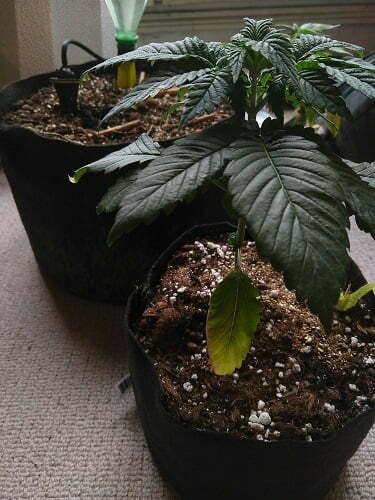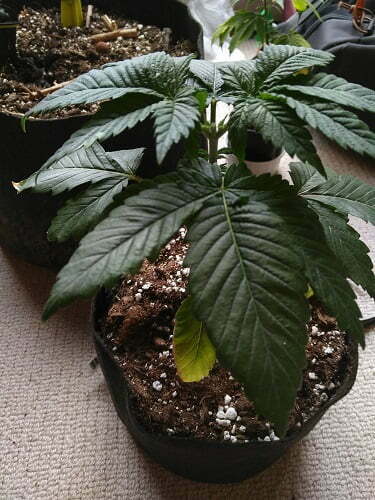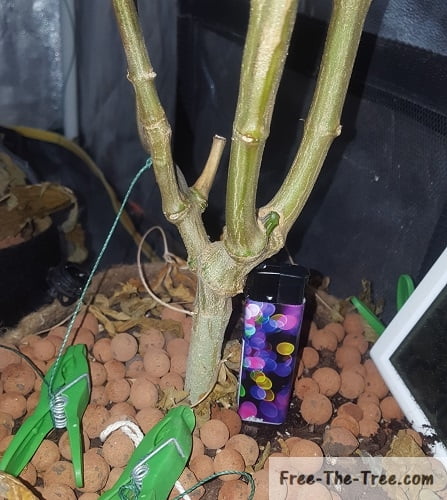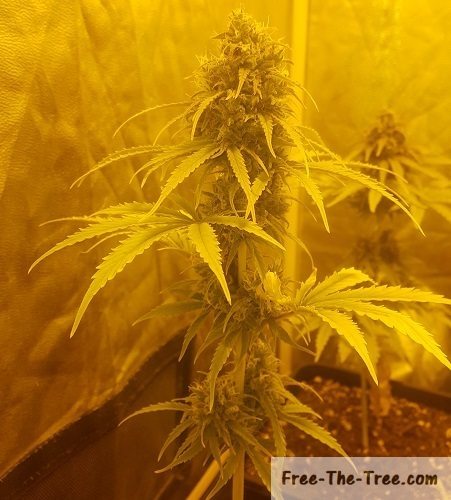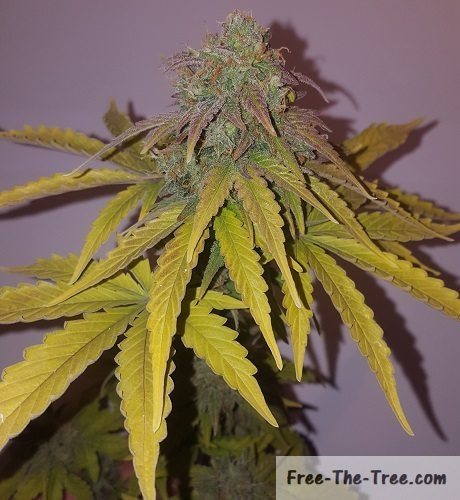Welcome back to our Critical+ 2.0 auto-flowering and Fruit auto-flowering series!
If you haven’t been following up here’s a little recap.
A little over a month ago we germinated 7 marijuana seeds, 2 Critical+ 2.0 auto-flowering and 5 Fruit auto-flowering. Unfortunately one of those fruit seeds didn’t take so we were left with 6 babies.
During the early vegetative stage we had couple issues with the balance of our sprouts and early stem with about 2/3 of our plants.
After that the flowering stage got going waaaaay too early because the main root hit resistance.. Yeahwhat makes the an auto flowering plant go into the flowering stage is the root system… something we didn’t know and learned with this one! We’ve covered all that in our guide on auto flowering seeds if you want to know more.
So here we are, after the first days of the stretch, and you’re going to see that she’s totally changing, welcome to the teenage years!
Day 32 – Auto-flowering seeds entering the stretch
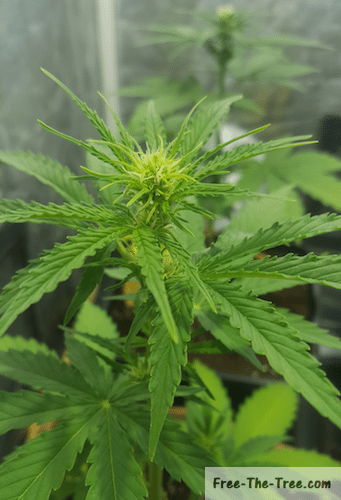
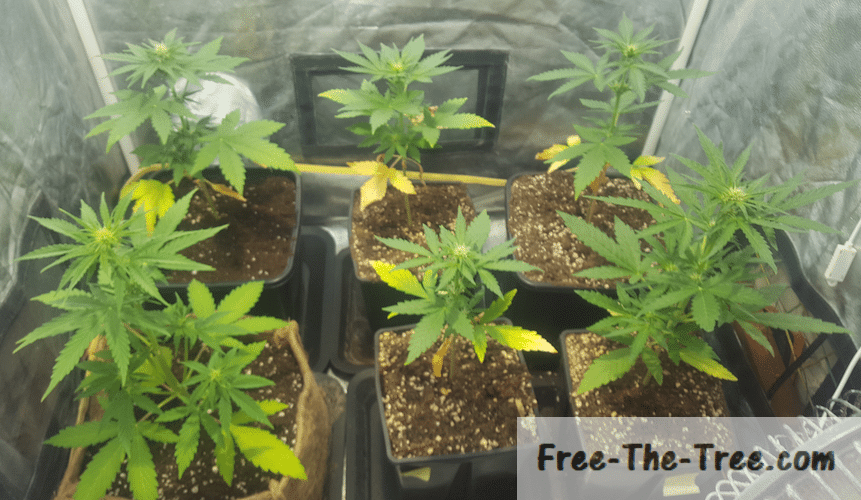
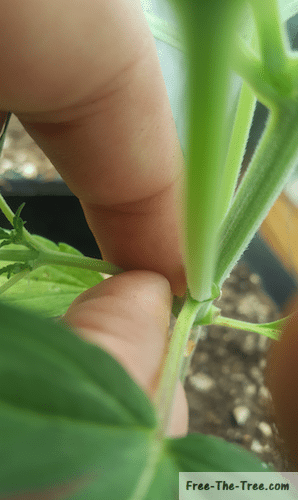
So during day 33 we started cutting (pruning) some branches and leaves. Normally you do this during the vegetative stage, but since we kind of got blind sided we’re doing this know.
We’re also having many deficiency issues as you can see with the colors of most of our plants.. Although it seems like the decision of lifting the lights about 15cm (5.9inch) did some good to them. Here’s a couple pictures of the leaves showing issues. We’ve got hypothesis’s on why it’s happening but still not sure… One we figure it out we’ll Update this section to let you know! (If you have an idea share in the comment section!)


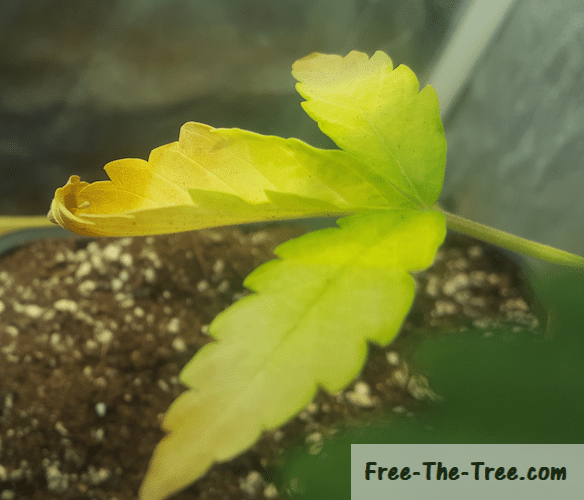
Spotting deficiencies during the stretch
So our suspicion here is Light burn. We hadn’t lifted our light yet since we put them in the grow room, it was about 20cm over head which isn’t that close, but they had been used to a light source that was further up so who knows it’s possible.
I know you might be telling yourself “that’s Nitrogen deficiency”. There are 2 things that go against that hypothesis:
- I’ve given them plenty, some of the plants with these deficiencies are actually also showing signs of nutrient burn
- The dead leafs aren’t falling of very easily, you have to pinch or cut them off to remove them from the stalk.
Now that second point is actually the one that hinted me off the most. Why? Because Nitrogen deficiency and light burn globally have the same signs, apart from 2 things. One of them being that with ND the dying leafs will just fall off, whereas with light burn they are hard to remove.
The only this that has me still hesitating is the fact that these signs are coming from the bottom of the plant, where normally light burn starts on top (second difference). But, these are also the main leaves receiving light, so it’s not totally crazy to think this.
In the pictures I didn’t show the next steps, but the leaf becomes all brown and dead, after which you need to pinch it or clip it off. This way to remove it is pretty unusual for a dead part of the plant.
Anyway, we brought the light up, hope it will do the trick.. they’re already not that big, loosing leaf mass is the last thing we want during the flowering stage.
This is a bit paradoxal with what I just said, but we’ve also been pruning some of our plants.
The one’s with the most deficiencies we’re cutting off all the side branches and pop corn buds, on the others removing the leafs in order to give direct light access to the branches below.
Pruning the marijuana leafs during the stretch
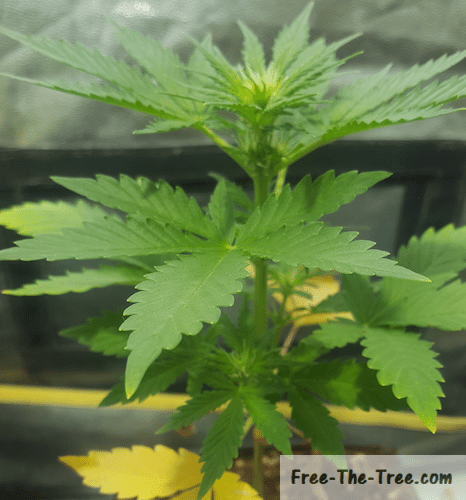

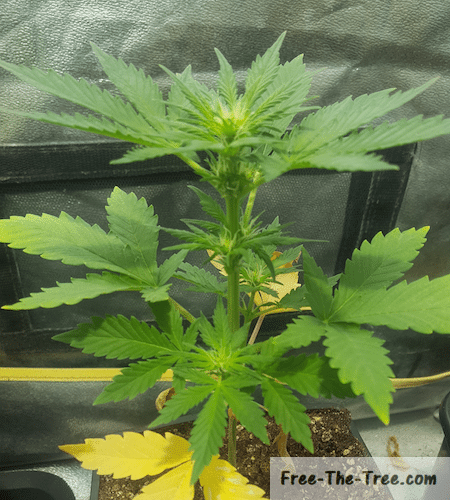
We’re going to go over the pruning (or cutting) of marijuana leafs and branches in 3 steps:
- How choose the leafs or branches you’re going to prune
- How to prune your marijuana plant
- What are we aiming for in this culture
In this example we’re taking a leaf as an example, but it’s basically the same thing with branches.
How to decide what to prune off your plant
During the stretch you really want to minimise extensive growth. The taller the plant, the more energy it takes to get the nutrients for the soil to the colas, as well as the “food” created by photosynthesis.
Keeping this in mind, if the branches you decided to keep don’t have direct sunlight due to a leaf making shade you need to cut that leaf. If you think it’s too risky because you don’t have enough leaf mass than cut that branch (or wait a little if you’re still in the vegetative stage).
Again, normally this is something best done during the vegetative stage since you can most likely recover, but we don’t really have a chance here.
Now that you’ve identified what you want to cut off, let’s look at how to do so.
How to prune your marijuana plant
- Identify the leafs or branches you want to remove
- Pinch at the intersection between the leaf or branch and the stalk of the plant. You can also decide to use a pair of scissors or clippers.
Whatever you use make sure you don’t damage the outer skin of the main stalk. - Clip the branche off
In the case where the branch doesn’t cut straight off and the other skin of the main stem is still attached, cut it as close as the stem as possible. Try to damage it as less as possible.
The days following this you will see the other sections of the plants grow more, the energy previously used at this spot have been reallocated!
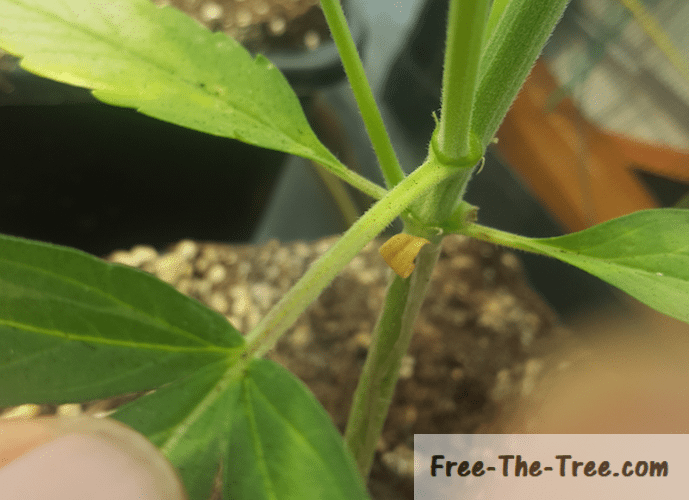

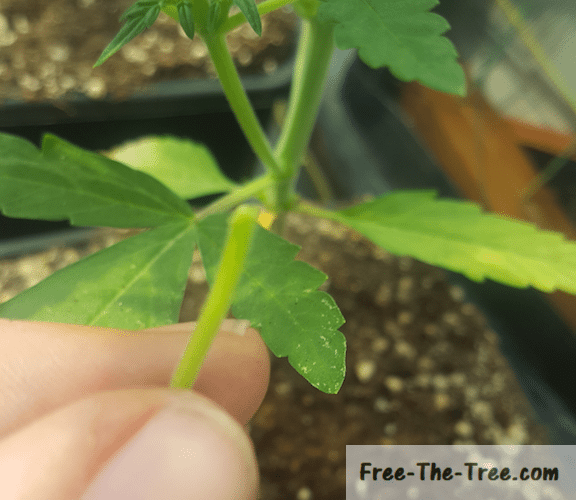
What are we aiming for in this culture
With 2 or 3 of our plants we’re decided to go for a one bud situation. The plants we picked only had 1 pair of small side branches and are the weakest ones. This will enable them to focus the energy they do have on their core flowers.
With the other flowers we decided to keep the main bottom branches, hoping that they will also produce a good amount of buds. We’ve remove all the “popcorn buds” or branches not receiving any direct light, hoping the cola buds will finish out to be nice and dense.
This means that on half the plants we had to mainly cut branches off, keeping the leaves for photosynthesis. On the other half we cut mainly leaves so that the main branches can have access to a direct source of light.
Globally we’re already aware that our harvest won’t be too crazy, this early flowering kind of screwed us.. But it’s alright, we learned something and could share it with you guys!
Day 33 – Nothing special to report
On this day nothing special really happened, so we’re going to share some pice with you guys!

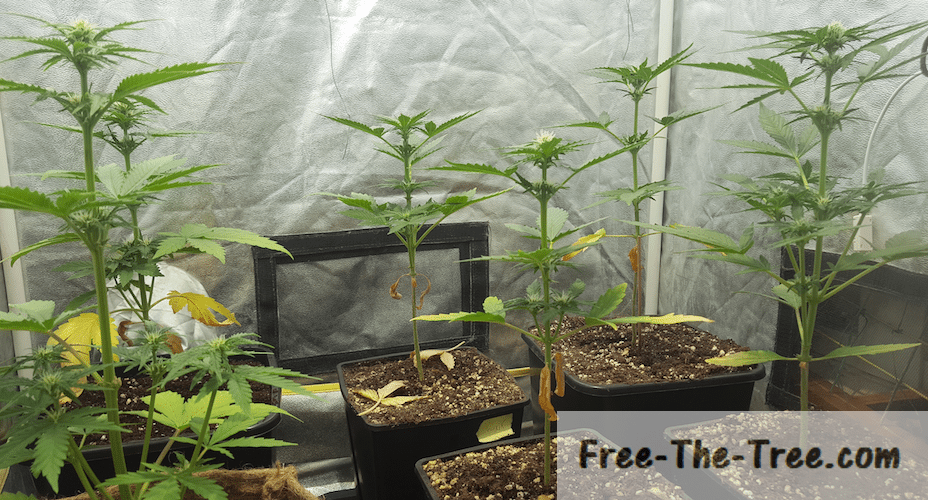
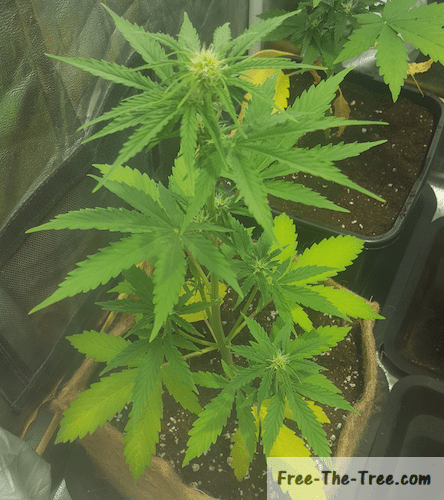
Day 34 – Changing to a Sodium Bulb
So we’ve entered the flowering stage for a couple days now and decided to change the light bulb so the sodium based one. The main difference between both is the light spectrum they emit. The vegetative light is more of a white/blue light whereas the Sodium based one if is more in a orange/infra red spectrum.
I’ve been reading around that during the stretch it can be good to keep the white light in order to reduce the spacing between the nodes, but honestly I don’t feel like doing more testing with these one’s, one yield isn’t going to be crazy, we’ll keep that test for the next run around!
Here’s a couple pics after the light change
P.S: remember to unplug your light before hand! I shocked myself, it hurts believe me!
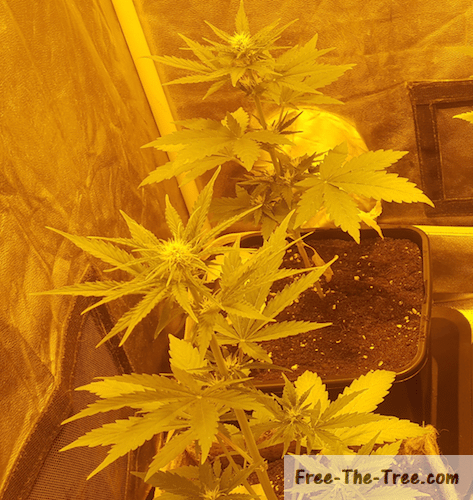

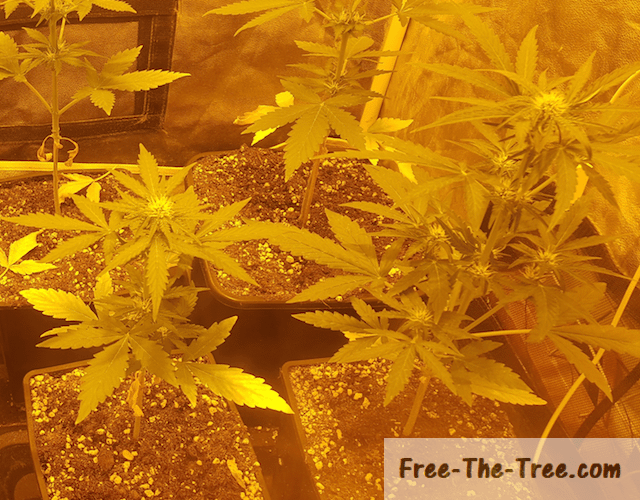
I don’t know if you guess which one’s we’ve decided to go for a one bud or not off these pics, we’ll let you know in the next article!
We’re also going to go for another round or pruning, but for the flowers this time. We want the energy of the plants to focus on the main flowers on the top colas, not the one’s further down the stem that have little chance to make anything worth it.
Until next time, be safe and grow easy!
Check out our previous articles on our Critical+ 2.0 and Fruit Marijuana Strains
Hey there and welcome (back) ! 🙂
Here we are, back at the beginning of a cycle! Can’t wait to share these upcoming weeks with all of you
Couple changes since last grow, so to start off clean here’s a recap of the strains and equipment we’re using
Grow Report 1 – Equipment & strains
- Strains: Critical+ (cuttings) & Laughing Buddha
- Seed Type: Feminized
- Seed Bank: Barney’s Farm
- Nutrients or Additive Used:
– Bio Grow NP and PK mixes
- Grow Lights:
– Vegetation Stage : 75W LED table
– Flowering Stage : 400W LED table - Grower experience: 6th grow
Alright, now that that’s out of the way, let’s get into the first steps of these little one’s lives 🙂
We’ve divided this article in 2 sections starting with the cuttings and end with the seed germinating
Critical+ Cuttings – Rooting process
As some of you are aware we’ve had a critical+ mother plant for a little while, this is our 3rd round of cuttings with her.
Here’s a couple pics of the process but, in full honesty, we slacked off a little and left them in the cups for too long, which made us lose 2 little ones and a bunch of time. If you want to know more on how to make a cutting, check out our how-to article over here 😉
Picking and cutting the branches
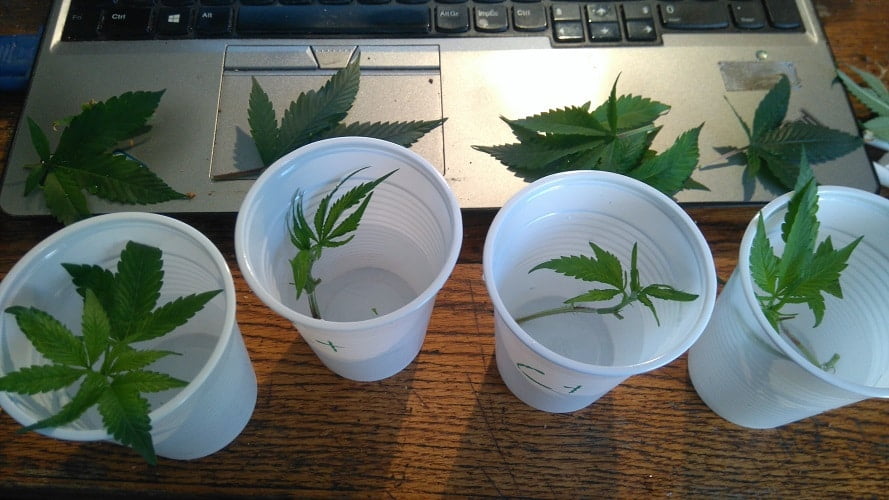
The first step to making the cuttings is obviously picking and cutting the right branches from the mother plant ^^
This round we started with 7 branches, planning that we would lose one or 2.
As we detail in our how-to article on making cuttings, the branches don’t need much light in order to root, what they do need it NOT to sweat, so don’t hesitate to chop off most their leaves (the left one still has way too many leaves) and place them in a very humid environment (aim for at least 90% humidity).
Cuttings rooting in the vegetation tent
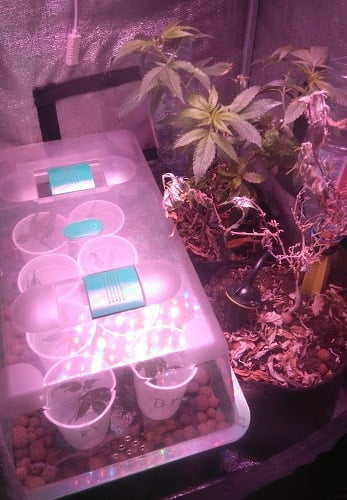
We left the little one in the cups of water for about a week, the time for some roots to grow.
At this point we lost one of the little ones, we had left the top latch open, it wasn’t humid enough and she didn’t make it… (told you we were slacking off :/)
As you can see on the pic one of our mothers isn’t looking well at all, all dried up and dying… We were so focused on the citizen lobbying tool that we didn’t water her enough and lost her :'(.
Passing the cuttings from water to soil
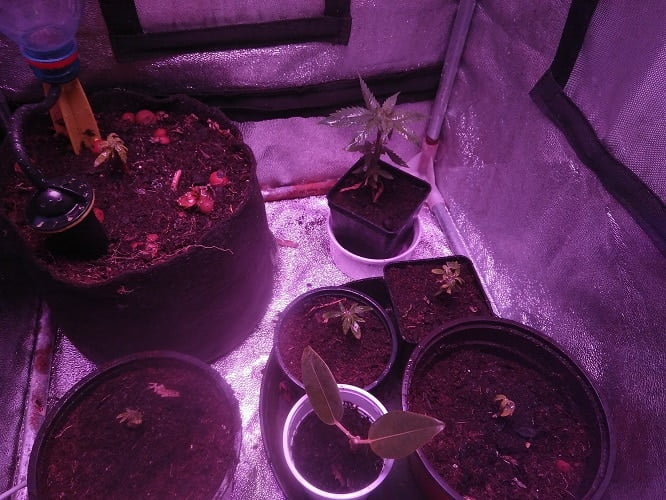
Once we had some nice roots we went ahead and transferred the cutting into our pots.
As you can see we have them in different size pots. The idea here is to keep one as a mother plant (top left). The 4 others we will re-pot and transfert into the flowering tent once they’re ready to stretch.
(Yep, we lost another little one between the 2 steps… we took wayyyy too long to transfert them into the soil)
That’s it for these little ones! As we speak they’re getting growing nicely, but we’ll tell you all about that in the next post 😉
Laughing Buddha Seed Germination
Here’s a little one we’re really excited about! First time growing it and really curious to see what it’s all about.
For a long time it was a best seller at Barney’s Farm, a coffee shop & seed bank in the Netherlands although now, unfortunately, a bit it’s harder to find these days.
Luckily, during our last trip in Amsterdam we were able to get a little seed! 🙂
(check out the trip on our insta account)
Alright, enough said, here’s some pics of the germination process of this little one
Seed Germinating – A humid and dark environment
Just like for the cuttings, we’ve made a full how-to article detailing the best ways to germinate your seeds, if you want to know more on that check it out over here

We set the little one in a humid paper towel between two bowls. At first it was wayyyy too humid in there, so we left a little crack between the bowls in order to let some humidity out.
5 days later, the tap root has broken the shell
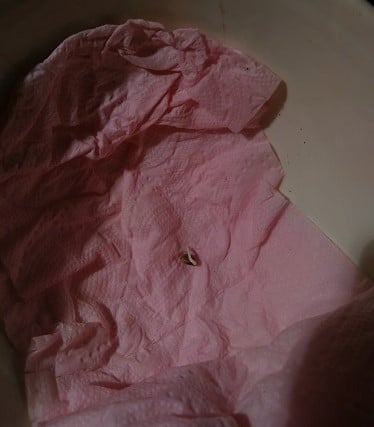
The morning after leaving the crack between the bowls we saw the tap root starting to break the shell; The picture above was taken that night and, as you can see, it’s big enough to plant 🙂
Seed you soon cotyledons 😉

With the tap root about a centimeter long we planted the soil, about 1.5 cm deep. This depth gives it enough room to break soil and deploy the cotyledons with little effort, while the tap root can get comfortable in her new home.
As soon as we covered the seed, we set the pot in a bowl of water in order to humidify the soil without disturbing the seed.
48 hours later – Soil has been broken and the cotyledons deployed
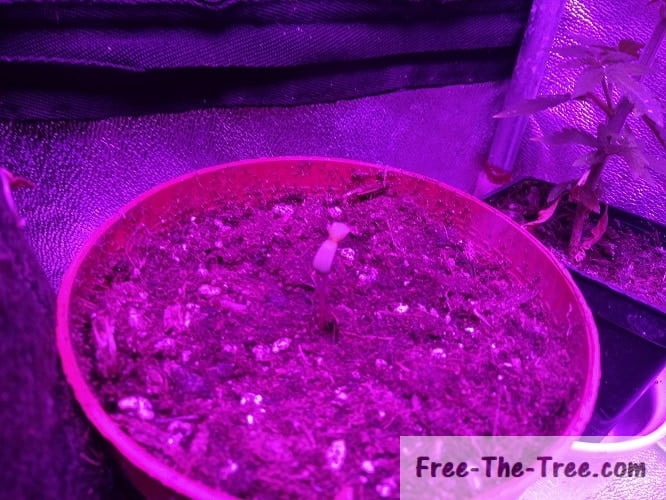
A little under 48 hours later she had broken the soil and deployed her cotyledons and, you can’t really see it but, the first leaves are starting to grow.
We actually missed the ground breaking process which sucks… so awesome to see ’em say hello to the world for the first time.
As we speak the first leaves are starting grow more and the cotyledons are starting to die out; We set the pot on a box in order to get the Apex closer to the light in order to avoid any early stage stretching, we don’t want her to get top-heavy ^^
Alright folks, that’s it for this one!
Until next week, be safe and grow easy 😉
Hey guys and welcome (back) to Free the Tree! This past week was full of events, this might be a long one.
We validated the fact that we had a Thrips invasion and not a Spider Mite one, thank god! (How to tell the difference? We did a guide here 😉 ) These suckers are much easier to kill than spider mite.
Also, since we’re in the late flowering stage we can’t really use anything on our flowers without taking the risk of spraying anything, even Neem oil could leave a taste and ruin the harvest.. So again, thank god it’s thrips and not Mites.
During this week we also saw some crazy Thrichome and bud growth 🙂 They’re smelling beauuuutifully
Let’s get started
Day 48 – Trichomes all over the place!
Our Critical + 2.0 has been growing more and more Thricomes on her buds, they’re all white and powdery, i’m loving this! here’s a couple pictures (which we had a microscope to show you what they looked like up close)
As always click on the picture to see the full screen version
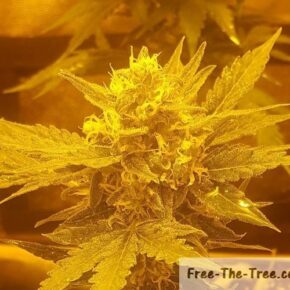
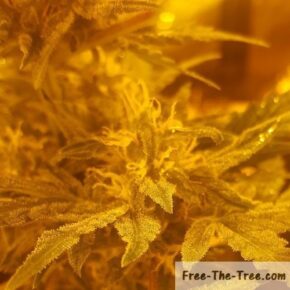

Can you see all those little white specs? Those are the trichomes 🙂
You may be wondering what the fuss is all about, we’ll do a full article very soon on this but basically here’s the deal.
Tricomes are what contain, at a specific moment in the plants development, a molecule called TetraHydroCannabinol, aka THC. Tricomes contain many other molecules such as CBD, produced by the Tricomes once they deteriorate (become gold like color)
At this time under the eye glass we can see that they’re totally clear which means that they’re not quite ready, we want them to be a nice milky color in our situation.
Trichomes are important to track since they’re the best way to know when to cut, so if you don’t have one yet buy a magnifying glass!
Day 49 – Fattening buds, Browning pistils and Nitrogen Deficiency
The flowers have been growing more and more with almost daily evolution, it’s really a pleasure to watch these plants grow, although we’ve been fighting these thrips (we’ll cover that in the next section).
As you can see the 2 plants on the far left are showing mid to late stage Nitrogen deficiencies with all leaves impacted. They seem to be further along the flowering stage than their 2 fruit strain counter-parts. I think this is due to the fact that their soil in much less compact, thus their root systems aren’t as solid.
On top of that we kept side branches to make an A/B test between this style and One Bud technique (What are the Different types of cultures? Here’s a guide).
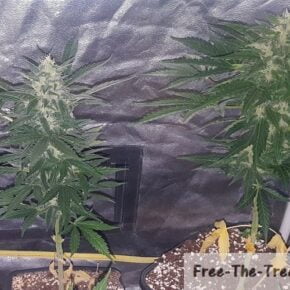
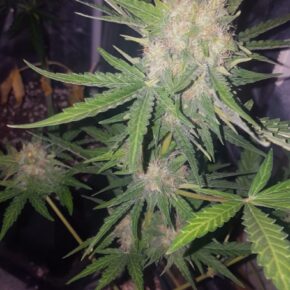
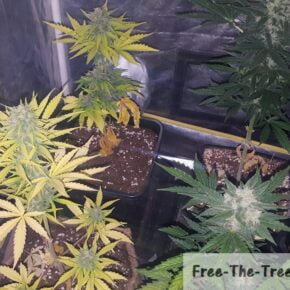
Browning Pistils – Round 1
In the middle picture you can see that the pistils have started browning, and as you may have read this can mean that the plant is ready, keyword being can.
Marijuana flower pistils will turn brown 2 or 3 times during the flowering stage so do not harvest here, you’ll be cutting yourself short of up to 50% of your harvest!
Those different rounds of browning pistils followed by the flower opening back up (white pistils) is her way to grown and increase the size of the flowers, you’ll notice those buds getting bigger and bigger as it goes on, but don’t wait too long! 😉
(If you’re wondering, the best way to identify when to harvest is by observing the trichomes.)
Day 51 – Confirming the presence of Thrips
As you may be aware, we’ve noticed signs of a Thrips or Spider mite invasion, we were leaning for Thrips since the white marks were spread out all over the place but we we’re positive.
In order to be sure we decided, for an hour or so, to drop the humidity levels, take the fans off the plants and raise the heat making the perfect environment for Thrips, hoping they would show their faces.
And sure enough, after leaving it for a little while we could see a couple of those suckers, both on the larva and post-larva stage (no adults though, suspect I killed it couple days ago).
If you want to know more about Thrips and Spider Mites we’ve liked to our articles below.
Here are a couple pics of these suckers, in total we had to have killed about 10 of them across all our plants.
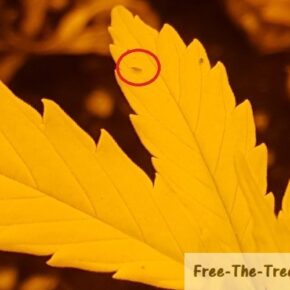

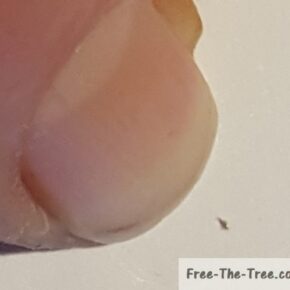
As you may know, Thrips are between 0.5mm and 1.5mm long, so they can be pretty hard to spot but it’s defenitly . In comparison to my index finger nail its super tiny!
If you’re wondering if you spotted one or not, move the leaf around you’ll be able to see if it moves or not. If it does than that sucker is a pest, kill it! (I used my fingers when I spotted some).
As we’ve said in our previous report, since we’re so far along within the flowering stage we can’t use any treatment by fear of leaving a taste in our buds, so we’ve been hunting them by hand and keeping conditions as unfavorable as possible for them.
Thankfully the infestation isn’t that bad and our plants are surviving it fine, showing healthy signs, smelling beautifully so we’re not too worried.
Day 51 – Cutting Side Branches
As we said further up, we tested different styles and one of are buds is really small, so we decided to cut the side branches in order for her to focus on the Apex for the end of her life.
It’s really late in the game to hope for a real impact of this, but we still decided to cut the for satellite branches, hopefully the main bug will get somewhat bigger.
Cutting the side buds
Here’s a couple pictures of how we cut the branches. It’s pretty straight forward, you place you scissors at the intersection of the branch and the main stem and make a clean cut.
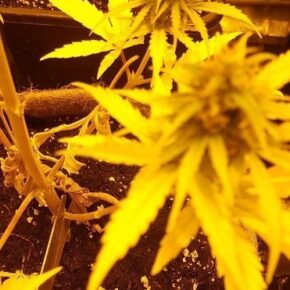
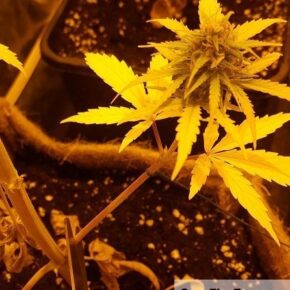
Curing Marijuana Buds
As you can see on the pictures below, these buds are real small, but they still look and smell beautiful, can’t wait to taste this Fruit strain :p
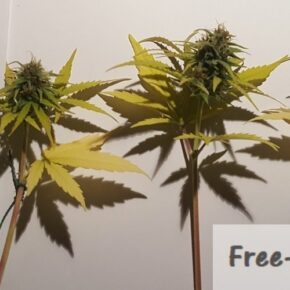

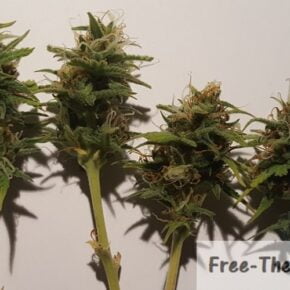
Curing the buds are one of the most important steps, the aim is to cut off all the main leaves and as many of the small leaves as possible.
Since this is personal consumption, and the small leaves near the buds have so many trichomes, we decided to just trim them; but if you’re intending on selling your harvest it’s more aesthetic to just keep the flowers.
Side note, keep your leaves and stems! we’ll do a full post on what can be done with them, from tea to hash you can do a whole lot with everything so don’t toss it out.
Day 53 – Fattening Buds and first signs of readiness
Although our plants are objectively small, which we were prepared for, some of these buds are getting nice and fat 🙂 The beautiful smell is all over the room and their shining with trichomes. It’s going to be a small but tasty harvest!
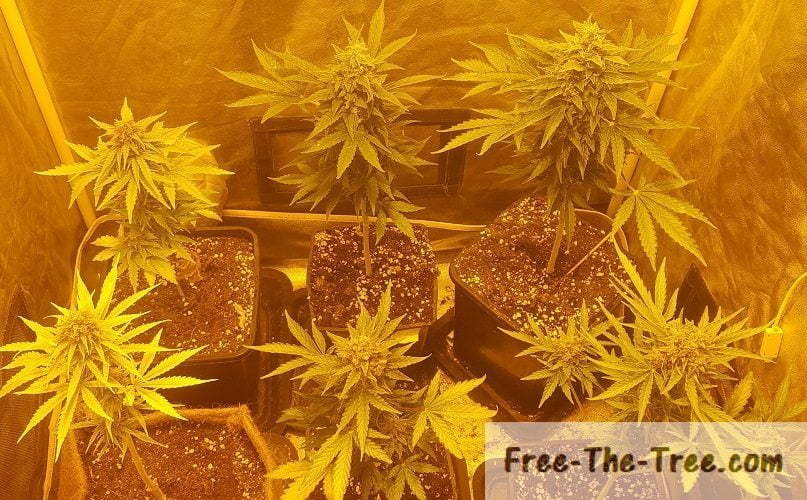

Curing Marijuana Buds
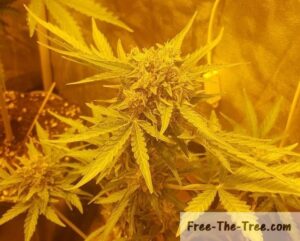
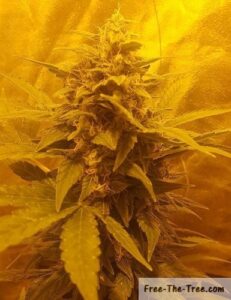

Alright guys that’s all for this one!
Until next time, be safe and grow easy 😉
Don’t wanna wait? Check out all our other Critical+ 2.0 Grow Reports
Check out all out Indoor Growing Tips
Hey there and welcome (back) to Free the Tree!
This week was pretty exciting, most of the trichomes have started to show, we decided to go ahead a cut down one of our Colas (way too early to do so), we started back building the buds aaaaand we finally got an image of a live, grown thrips (find pleasures in small things right ^^)
Let’s get into it
Trichomes turning milky
We’ve been watching the trichomes closely for the past couple weeks and they’ve been starting to get nice and milky, especially the ones on the side leaves.
You can see on the image on the right hand side that the trichomes are mostly milky with a couple still clear.
Since we’re looking for more of a upper effect we really want to harvest while the THC levels are at their highest, meaning when they’re all milky and have just started turning milky. Seems like harvest is coming up soon 😀
Important note: Something we discovered by the end of the week, but in order to measure readiness looking at the leaf trichomes isn’t reliable. You must look at the flower trichomes or the ones that are are the very small leaves sticking out of the buds.
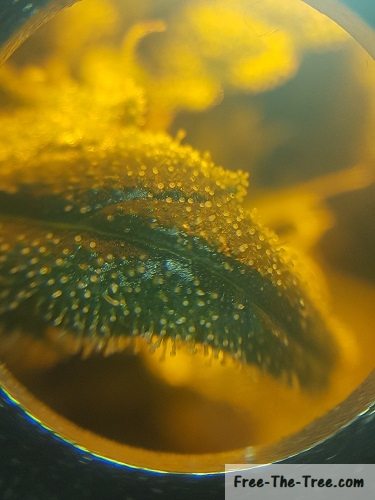
First Big Buddha Cheese Harvest
By the end of the week, after looking at many trichomes we decided to harvest a first cola.
We did this for two main reasons
- It seemed to be at that THC peak
- That cola was really pressuring the Blue Thai, which doesn’t have enough room and isn’t looking too great
Turns out, we really harvested her too early, as we said most of the trichomes are milky but there’s still many clear ones.
This bud definitely would have been much more massive if we had waited about 10 days before harvesting her… But at least we have a clear view of the development stage of the Big Buddha Cheese.

Harvested cola after pruning
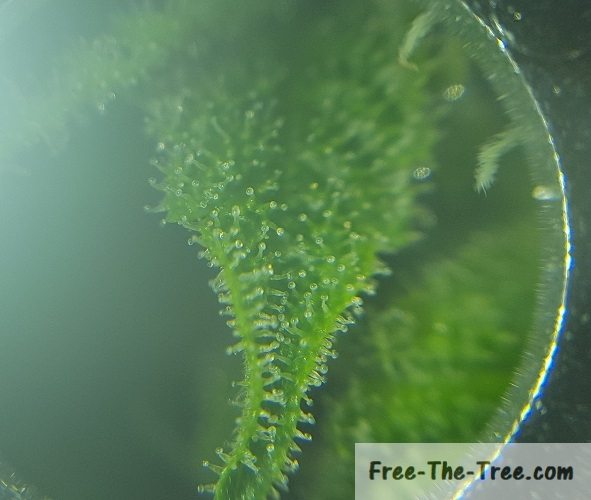
Clear and Milky Trichomes – Harvested too early
As you can see on the image on the right hand side some of the trichomes are still clear, we really cut this bud too early.. oh well it’ll be a soft taste of the rest of the BBC plant.
Back Building the buds
After cutting that the BBC bud we started looking into different ways to improve yield during the last weeks and crossed the “Back Building” technique. After reading into it seemed to be pretty effective, tested by many people within the community so we figured let’s try it out ^^
Basically the idea is to remove the top tip of the flower. The way marijuana flowers response is to stop growing in height and start getting thicker and fatter. Here’s a good video we crossed that shows how to do it pretty well.
Hopefully it’ll get the buds much fatter 🙂 keep you updated in the next reports
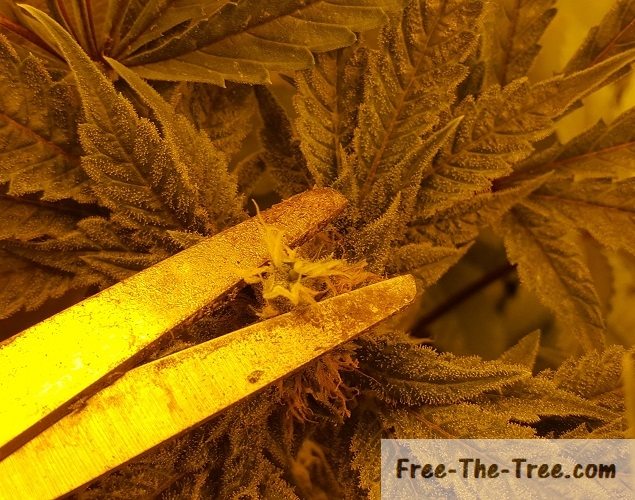
Back Building marijuana flower
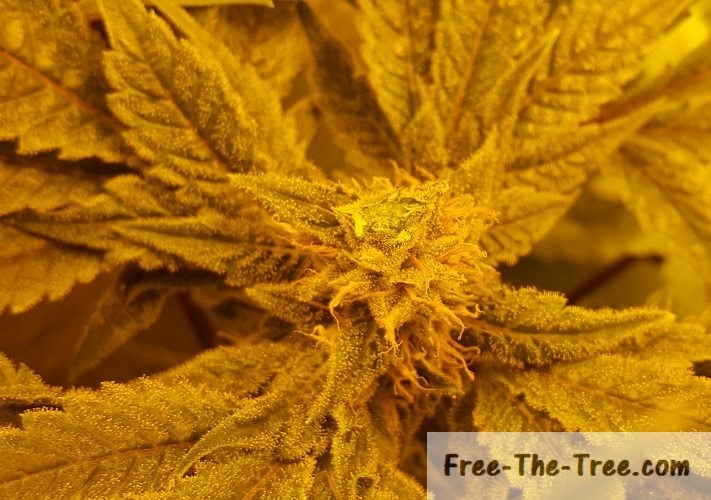
Top tip of the flower cut off
Thrips Thrips Thrips
While pruning the bud we harvested today we noticed one a couple thrips larvae and one adult thrips fall off.
Here’s two pictures of the adult thrips, if you want think you have a Thrips issue we’ve grouped everything together over here.
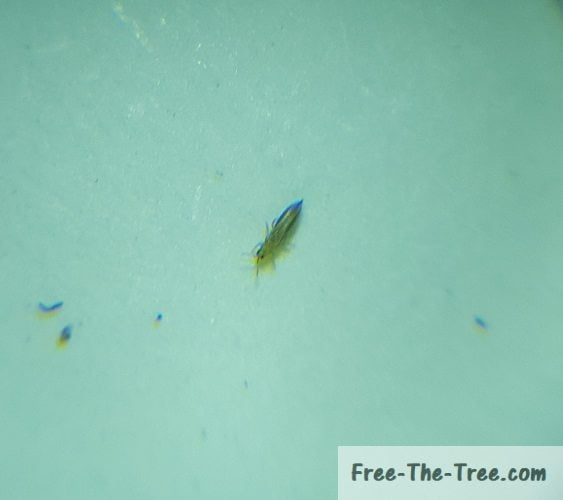
Front side of Thrips – Black streaks visible

Back side of adult Thrips – Looks whiter
Alright folks that’s it for this week.
Until next time, Be safe and grow easy!
Miss a couple episodes? Here’s all our other Grow Reports
Read up on our Indoor Growing Tips!
Hey there and welcome (back) !
Much has happened since the last grow report, from dealing with our fungus gnat infestation to germinating a new little strain, we had a lot of fun 🙂 Let’s get right into it
Grow Report n°4 – Table of Content
- Fungus Gnat vs Nematodes
- Phytoseiulus persimilis protecting our babies
- Sex Bud – New strain germinating
- Topping our Laughing Buddha
- Blue Thai showing problems
- Curing the Blue Kush
Nematodes vs Fungus Gnats – Get eeeem!
This week we finally got the Nematodes, these little worms are a natural predator for Fungus Gnats eggs and larvae, perfect to go hunt and kill these suckers and protect our babies root system 🙂
We’ll do a full article on fungus gnats shortly, but basically the nematodes enter the larvae or eggs and develop in there, feeding on the insides of the fungus gnat.
Within a couple days, the effected larvae is dead hehe.
On top of that, nematodes keep the soil healthy, eating through the soil and adding nutrients to it, so it’s also a long term investment.
Nematodes in soil (jammin’ to the black eyed peas)
Phytoseiulus Persimilis protecting our plants
If you’ve followed our previous grows, you’re aware that we’ve had some intense battles against spidermites and thrips.
We’re sure that there’s eggs left, just waiting for the right weather to hatch and start back up this infestation (yeah these suckers can hibernate for months).
With that in mind, we decided to go ahead and get some phytoseiulus persimilis in order to introduce them to near our vulnerable plants.
Hopefully, this year will be one without spidermites!
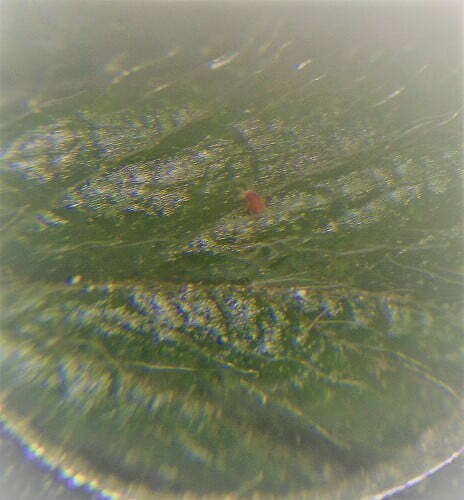
Phytoseiulus persimilis on strawberry leaf
Phytoseiulus persimilis hunting Spidermite – Credit to Kopper Biological Systems
Sex Bud Germinating
Sooooo exited about this, here’s our first full sativa, the SexBud by Female Seeds. Her parents are the C99 and White Grapefruit, giving a fast flowering sativa (8/9 weeks), with a stimulating, creative and energetic social high. Can’t waiiiiit to see her grow.
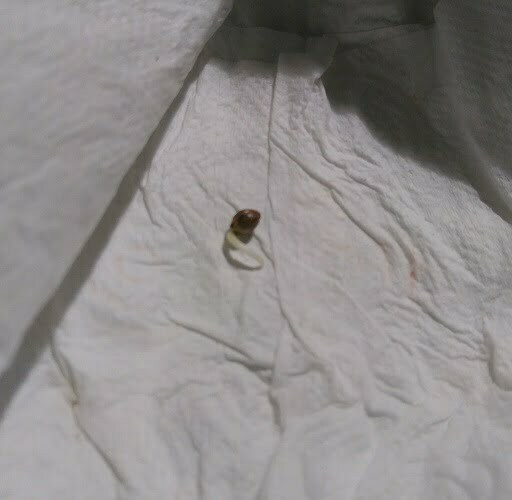
Seed germinating in paper towel
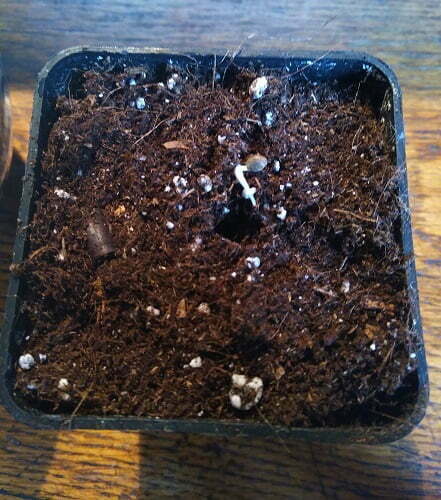
Germinated seed going into the soil
She germinated within 24 hours, although we left her in the paper towel a big longer in order to let the tap root grow a bit.
As we speak the cotyledons have opened up and the first fan leaves are starting to show hehe
Topping the Laughing Buddha
This baby has been growing so nicely, originally we were scared she would get top heavy, but nope, she grew a nice stem and is now growing faast!
Although we’re not sure that we’re going to scrog this round wedecided to top this baby in order to get multiple Apex’s. From there we will make a cutting off one of them for a mother plant, than get this beauty to flower 🙂
Blue Thai showing problems
For the past week the blue thai is showing issues. We though it was linked to the fast that she was still in a small pot, but the leaves are still turning yellow..
We’re hesitating on a nutrient or light burn situation.. To be safe, we flushed the soil and lifted a bit the light.. hopefully the situation will improve
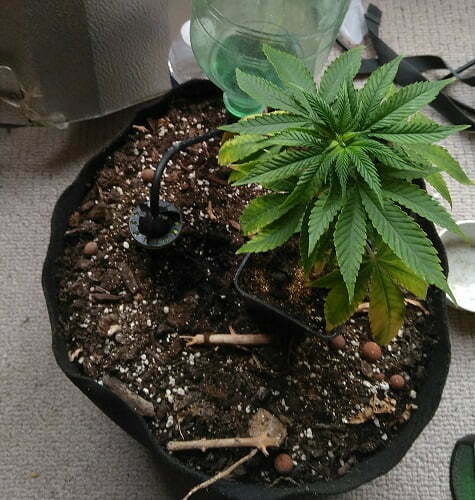
Leaves starting to turn yellow
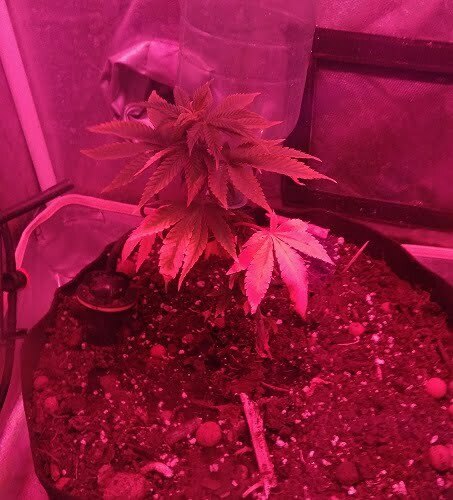
Issue is spreading
Curing the Blue Kush
Sooo we didn’t share this grow on here (too busy on the citizen lobbying tool crowdfunding at that time), but we just couldn’t resist sharing this little beauty

Blue Kush – Ending her flowering stage

Dried flowers curing it a container
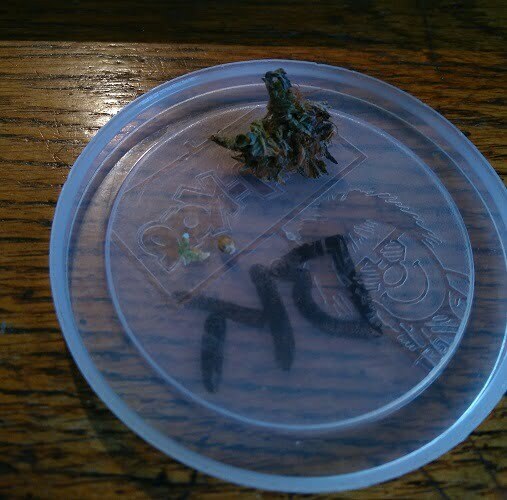
She gave a seeeeeeed!
We harvest her couple weeks ago, she’s now curing and soon ready to be smoke hehehe 🙂
Honestly we didn’t even weigh the final yield, as a g*d d**n spidermite attack impacted strongly her development around the middle of the flowering stage…
That said, isn’t she beautiful?
Alright folk that’s it for this one! Until next week,
Be safe and grow easy!
Hey there and welcome (back) to Free the Tree!
This week was pretty cool, we received 4 beautiful Big Buddha Cheese cuttings, most our seeds broke the ground and we transplanted most our plants into air and fabric pots. Let’s get into it.
First Cannabis plants sprouting
Within a couple days after planting the seedlings, the first plants started to sprout. As we started to say in the previous post, we weren’t going to make the same mistake as last time so we got these little guys straight into the grow room.
We installed a CoolTube since last grow so our heat issues are under control and not an issue anymore. Here’s a couple pictures of them breaking the ground
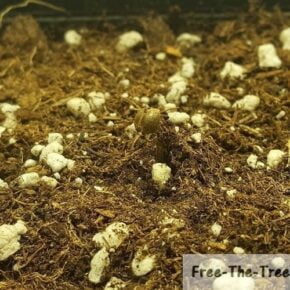
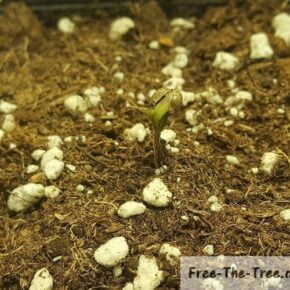

These 3 pictures were took within 24 hours, isn’t it crazy how quickly things happen at this point in time?
Down under the soil, their root system are starting to grow and conquer the space.
Big Buddha Cheese cuttings
A friend of ours that lives in the state next door has been nurturing a BBC strain for a couple years, increasing its strength and Render.
Our first plant was a cutting from her, you can check out the couple articles we’ve done on that grow here, needless to say we’re really excited to get another crack at her 🙂
He had really we prepared them for us, although they did have a couple deficiencies going since we waited a little too long to get out there.
Here’s what they looked like during the first couple days (as always, click on the picture to get the full view)
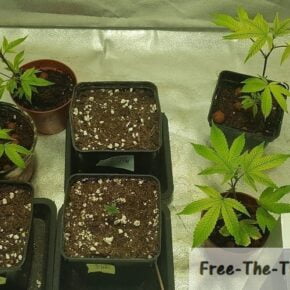

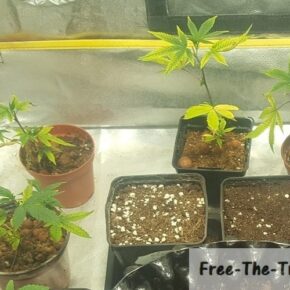
After receiving these little ones we needed to give them a couple days to get recover from the stress of the transport and all, after which we will select 2, transplant to larger pots and defoliate them so that they quickly grow new and healthy leaves.
Air pots and last sprouts
By the end of week 2 all our seedlings had sprouted apart from the two seeds that died (RIP).
We also decided to get 2 of our plants into our air pots right away. We also hesitated to transplant the BBC plants but decided to wait another day or two.
On the other hand, the Blue Thai (BT) and Cheese plants are really growing slowly, whereas the Blue Kush, that sprouted after the BT had already grown nice first leaves.
We’re not sure if it’s due to the fact that they’re in the Air pots while the BT is in regular pots, but that would seem logical.. We might have been better to wait a little before getting them in those pots. Check them out

Cheese plant just breaking the ground
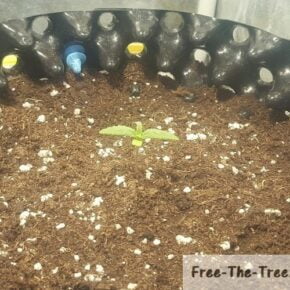
Blue Thai growing first stage leaves
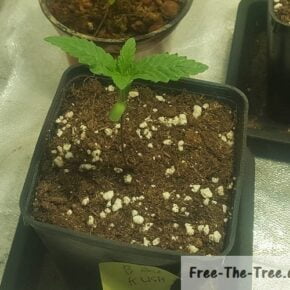
Blue Kush in the early Vegetative Stage
Now like we said, that Blue Thai had actually broken the ground before the Blue Kush, see how much of a difference?? I really feel like it was an error to get them that quickly into the air pots that quickly.
Well folks that brings us to the end of week 2, see you guys next week 😉
Until then, be safe and grow easy!
Don’t want to leave just yet? Check out our other Grow Reports
A question? Check out all our Indoor Growing Tips
Hi there and welcome to the last grow report of the series!
If you’ve been following these, sorry for the time it’s been since the last report, we’ve been working hard on getting the Price and Strain comparison tool usable and on the (soon to come) crowdfunding campaign!
We want to get the V1 of the Communities Lobbying Platform up and running by September 🙂
Let’s get back to the grow report though: this past month has been pretty full of events, we had time to harvest, dry and start curing the buds and even smoke a little since the last grow report!
In total we harvested about 250g of dried buds, pretty happy with it, but it’s not to say we didn’t make a bunch of mistakes along the way.
Let’s get into these last steps of our babies lives:
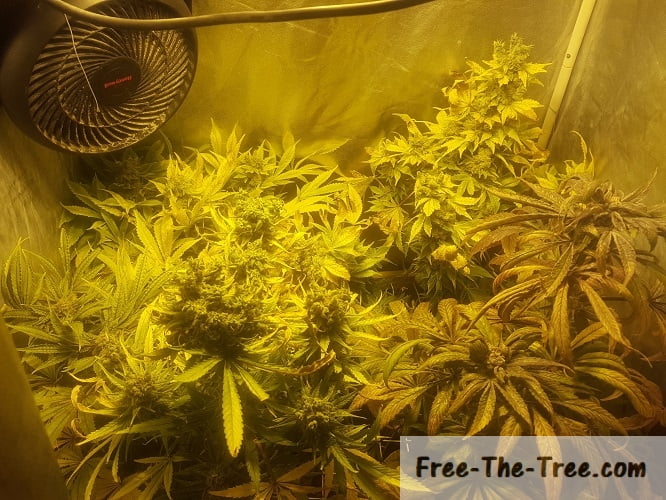
Grow room at the beginning of the Week
The Last Week – Harvesting Gradually
Since we had different strains in the front of the room, and couldn’t get well enough to into the back to be sure for the Big Buddha cheese plants we decided to harvest gradually over the course of about 10-15 days (started in previous grow reports).
Harvesting the Big Buddha Cheese Plant
We really had about 3 rounds of harvesting over the week with the BBC, first we cut a couple buds then went for the finish.
As they say, a picture’s worth a thousand words, so here’s a couple thousand words worth of bud harvesting :
Round 1 & 2
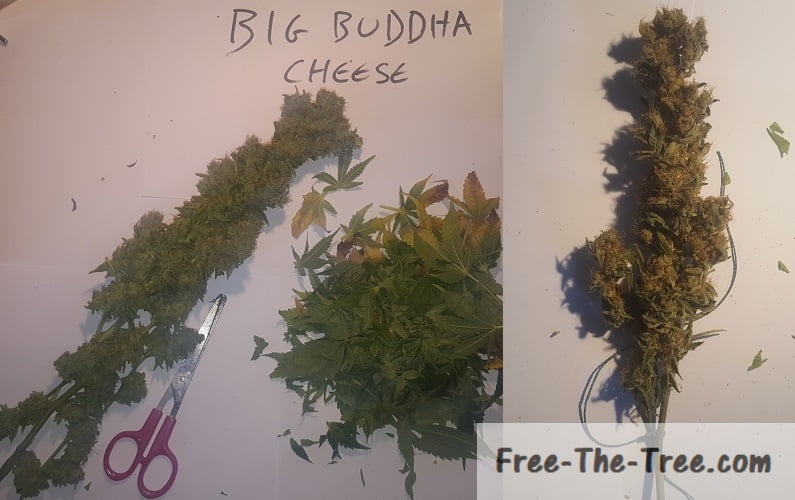
Buds harvested at the beginning of the week

Colas harvested a day or 2 later – Before pruning

Bud After Pruning
Here’s a quick picture during the middle of the week, these are all the first BBC buds and the Cheese plant drying.
After this pic some of the buds were ready to get into the jars to start curing.
Curing enables the buds to continue drying slowly. It’s really important as it helps remove the moisture, affecting the potency of your plant. Check out our full article on curing.

First Buds Drying in a Dark Area
Main Big Buddha Cheese Harvest
Let’s get to the real harvest for the BBC, took us about 4 hours to clean up all the buds and get them to dry. Takes a lot of time to get some nice, tasty, flowers in the end

Flower before pruning the leaves
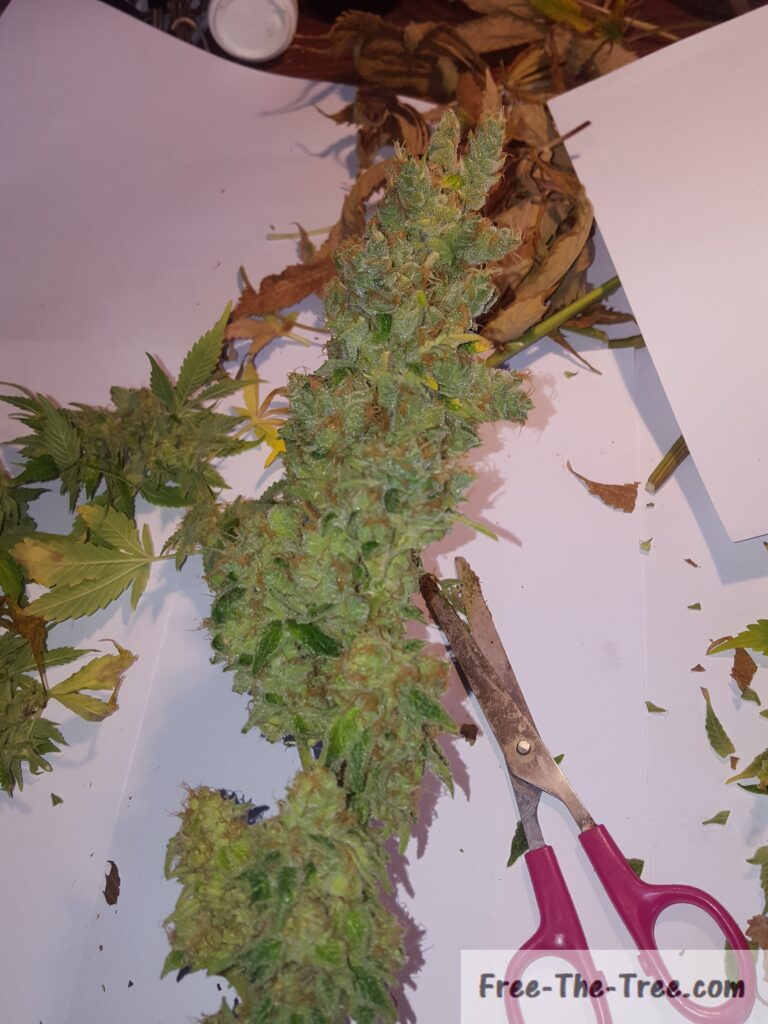
All leaves removed, ready to dry

Light Exposure during Night Hours created some funny looking Apex’s
Light Exposure during the Flowering stage
This is something we hadn’t really covered since I thought it was linked to the Calcium deficiency we had. After talking with a friend she shed some light on this.
See that picture above on the right? How the flowers are growing in separate ways instead of forming the usual, cone-like, flower? This is linked to the fact that light must have been leaking into the grow room at night, stressing the plant.
Let’s get back to the Harvest 🙂
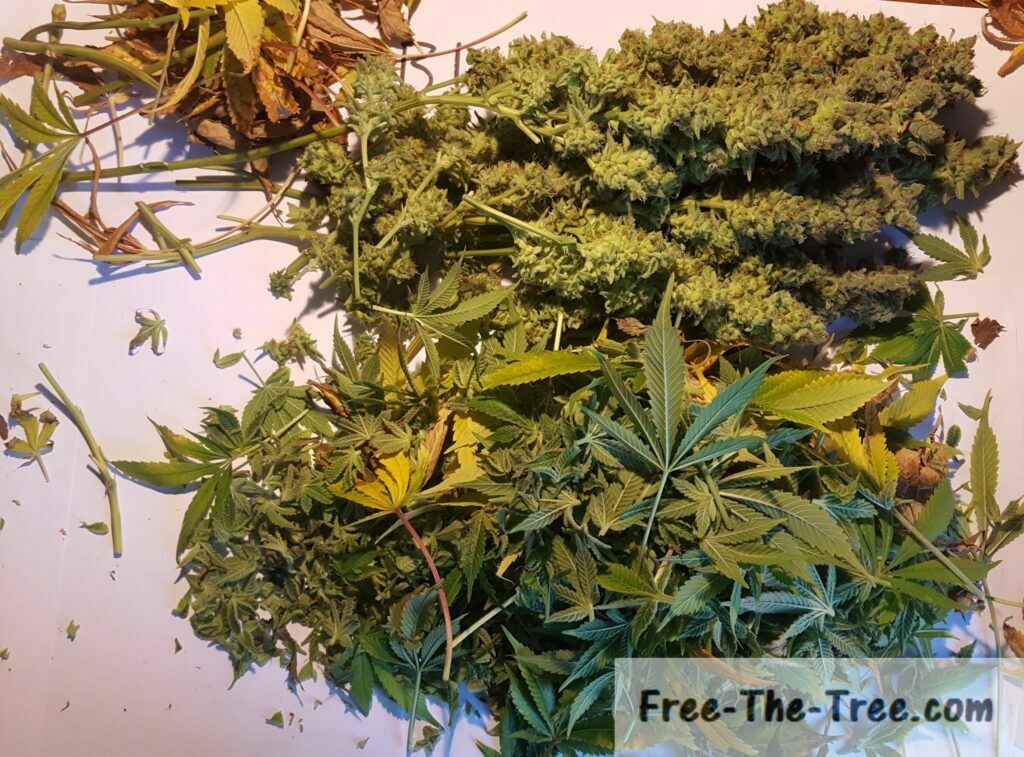
Stack of harvested BBC Buds and Leaves
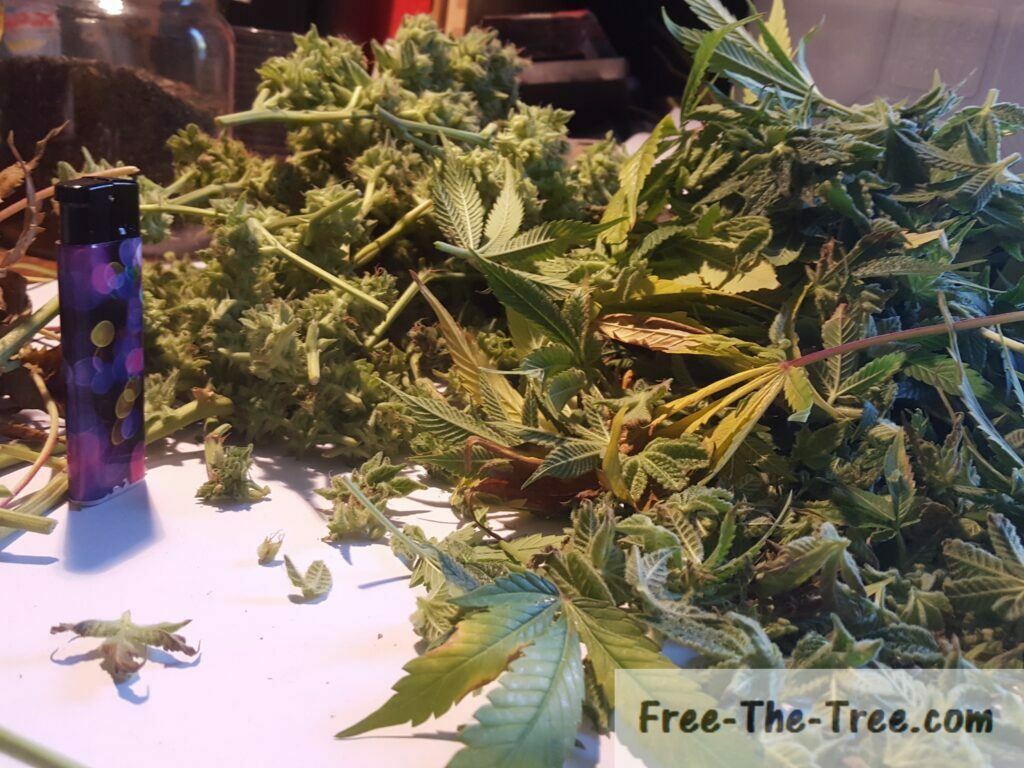
Horizontal view of the stacked buds
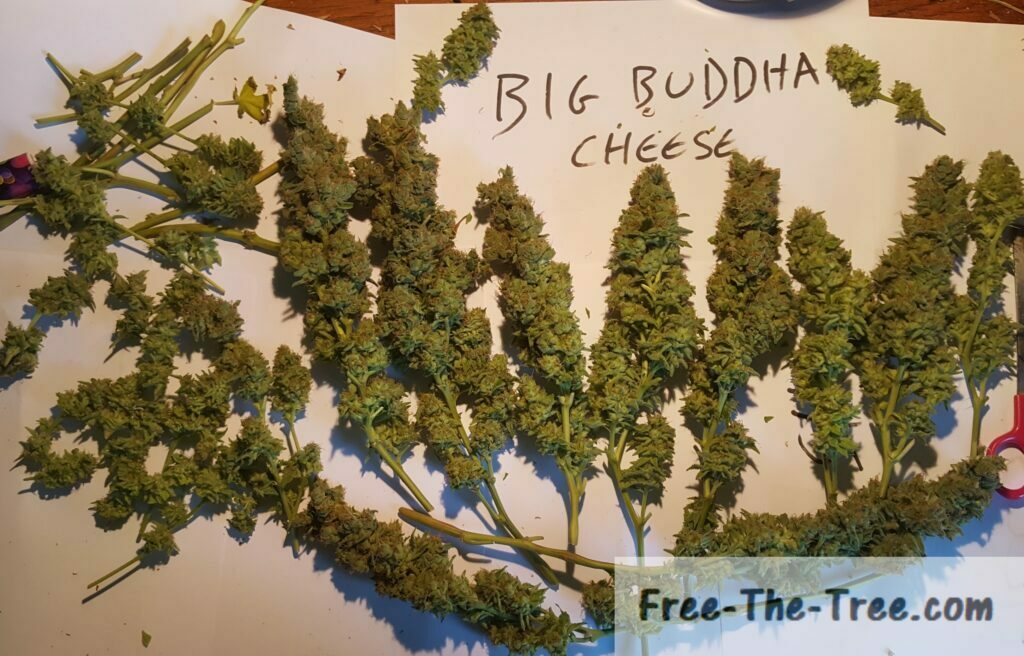
Main BBC Harvest – 10 to 15 Colas ready to dry
Once all the buds were nicely pruned, we attached a string at the bottom of the stem in order to hang them up side down to dry for about 10 days (until the moment where, when folding the stem, it cracks, without breaking).
Harvesting the Cheese Plant
Our Cheese plant really was a tree ^^ Appart from topping her about 2/3 weeks ago due to her height we harvested her at once, her trichomes were nice and milky, think it’s one of the ones we timed the best.
Her’s what she looked like out of the grow room (as always, click on the images to have the full view)
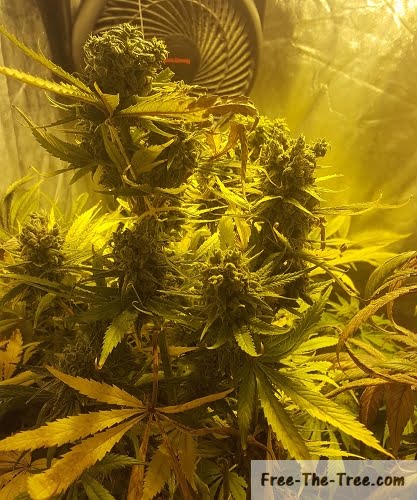
Cheese before harvest
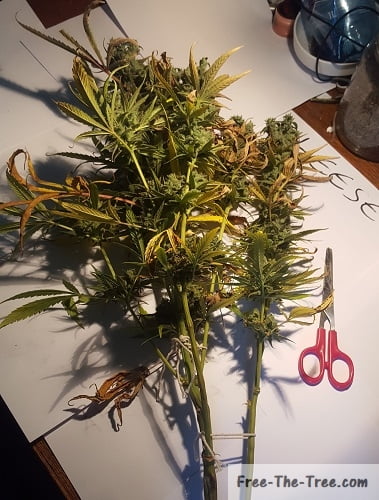
Freshly Harvested Tree
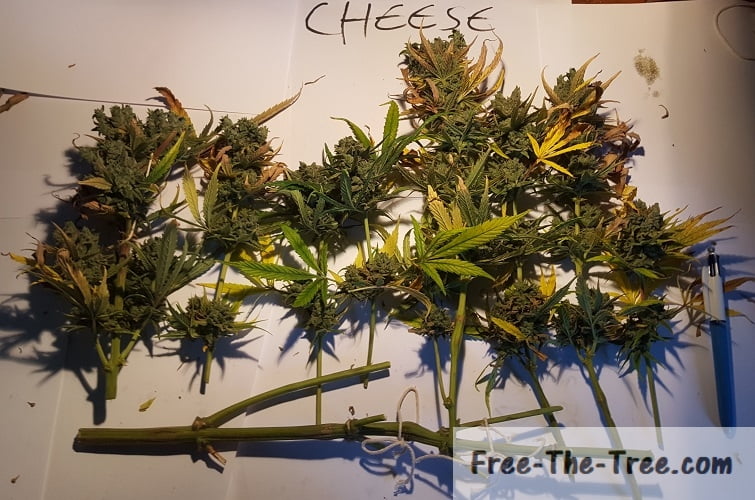
Branches cut from the tree and ready to be pruned
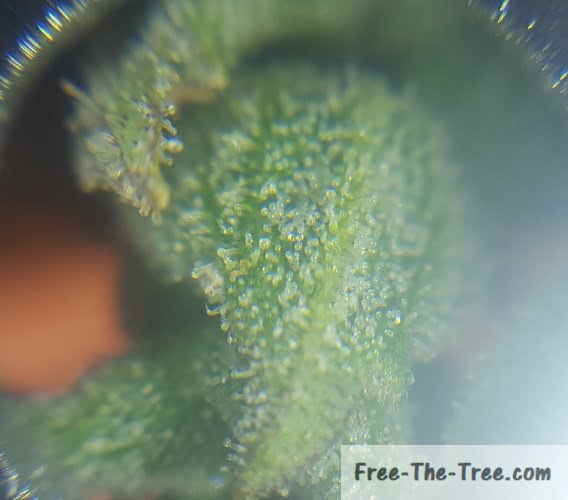
Whole bunch of nice, milky trichomes
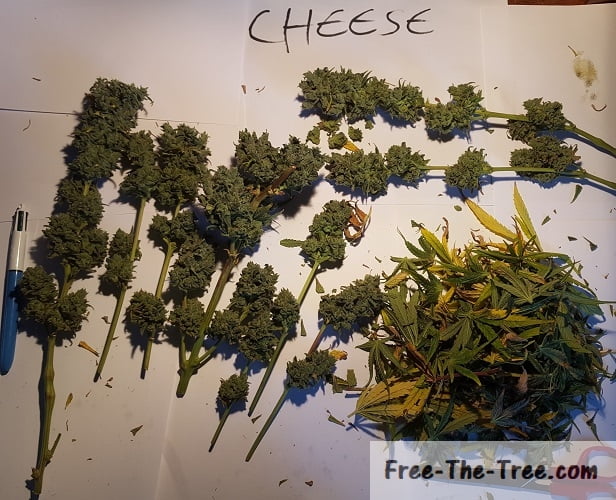
Buds pruned and cleaned, ready to dry
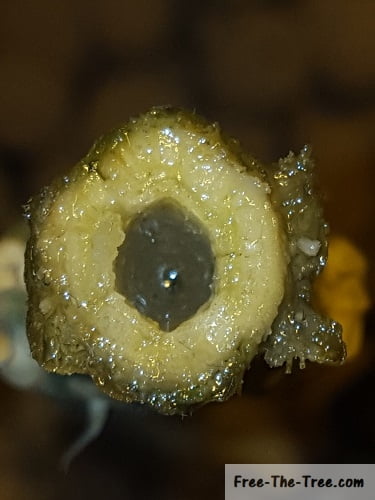
The sap kept flowering for a couple days, showing that the roots were still active!
It’s really too bad she had stretched as much as she did, I really think that she could have produced much more buds if she wasn’t as close as she was to the bulb.
We def should have scrogged her like the others in order to reduce her main height. Good to know for next round ^^
Harvesting the Blue Thai Plant
This little one was pretty small, since the cheese stretched it basically hid half the plant for getting a direct source of light so we weren’t expecting much.
Her smell is crazy though, full of spices.
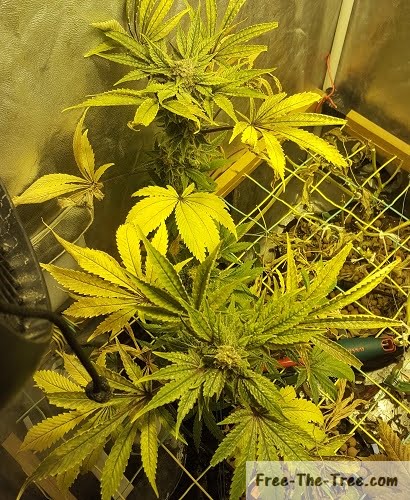
Blue Thai plant freshly harvested
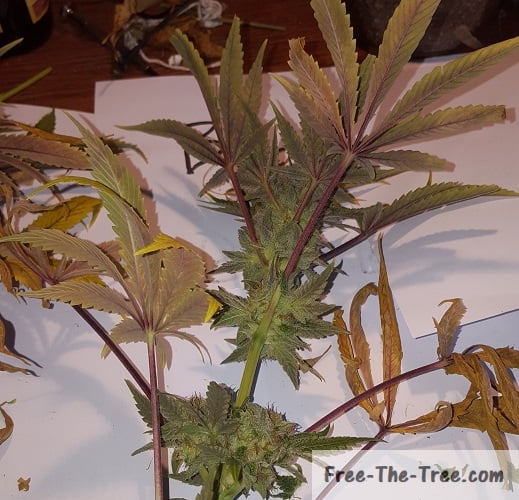
Branches cut from the tree and ready to be pruned

Small Blue Thai bud with purplish color
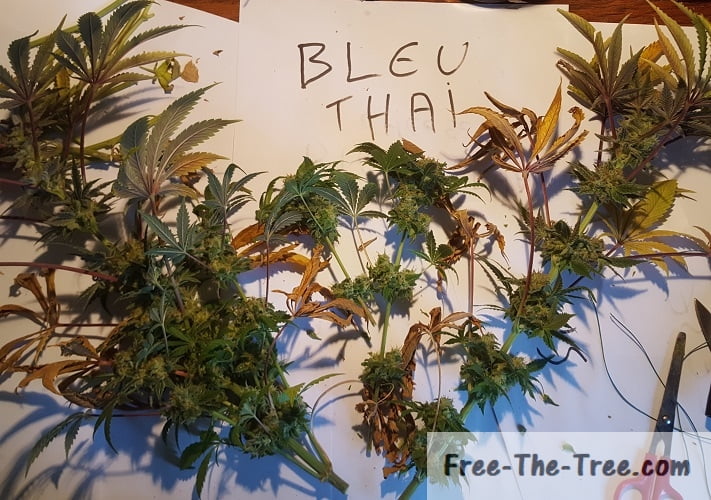
Each cola’s cut, ready to start pruning
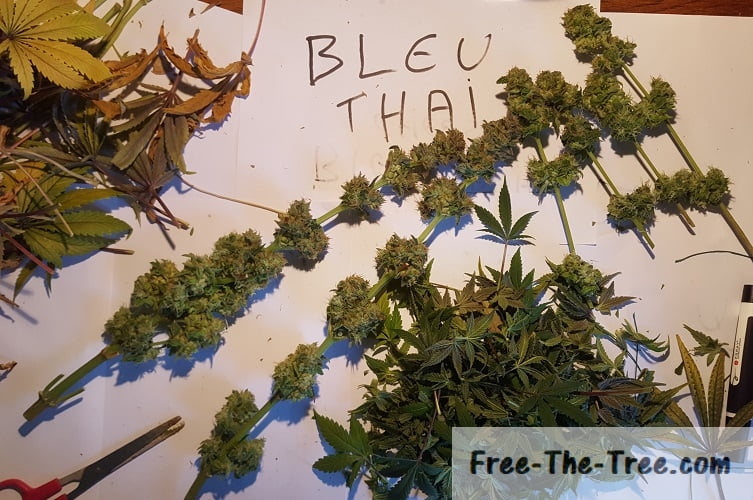
Pruned and ready to dry
As you can see the flowers aren’t that dense around the stems which is unfortunate, letting that cheese plant stretch so much really did damage to the yield of this little one.. (and to the blue kush up next)
Harvesting the Blue Kush
The Blue Kush is a pretty beautiful plant, especially since we were able to get temp differences over 10°C between day and night hours, allowing the plant to get that purplish/blue color. Unfortunately, she also stretch hard due to the Cheese.. Competition for the light source doesn’t joke around ^^
As you’ll see in the images below, she really built up her stem size, producing only a few scares buds 🙁
She really suffered a lot more from the heat than the Cheese plant

The Blue Kush’s last instants in the tent – You can see the heat stress on the Apex
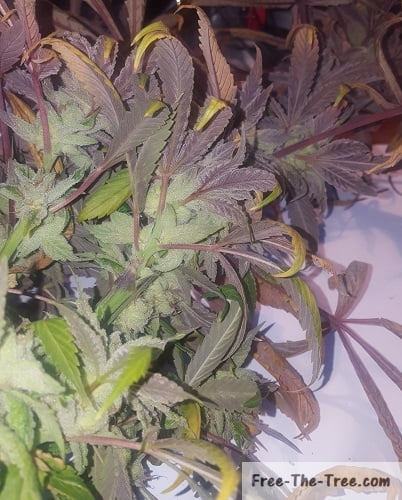
Freshly harvested Blue Kush Cola wearing her Beautiful Purple dress
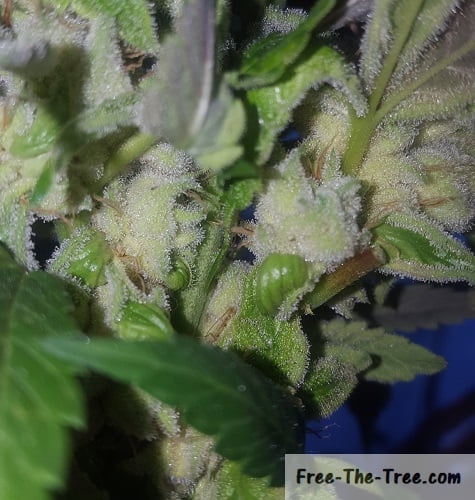
Focus on bud full of Trichomes

The 3 Blue Kush Cola’s harvested. More leaf and stem than bud

Pruned and ready to dry
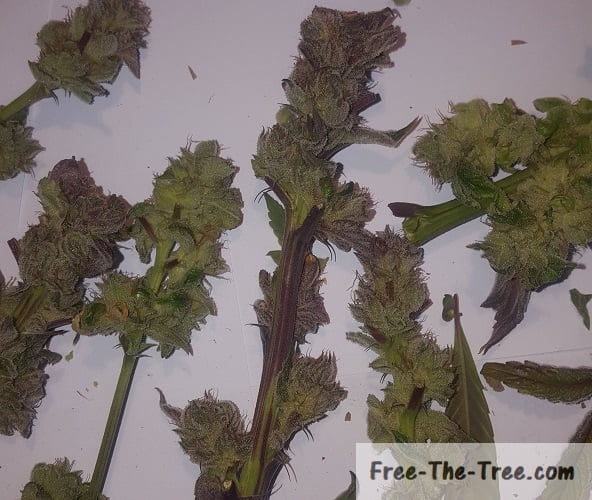
Close up on some of the purple flowers
Between the stretch for light and the heat stress generated from being so close to the light this “little” one really didn’t produce a lot of buds, although she really was beautiful.
I don’t feel as bas as the Blue Thai since we’ve germinated 3 seeds of this one for the next round, we’ll get another crack at her 🙂
Remaining Stems & Roots
Before we get to drying and curing of the buds, check out the nice stems and root systems these babies had developed
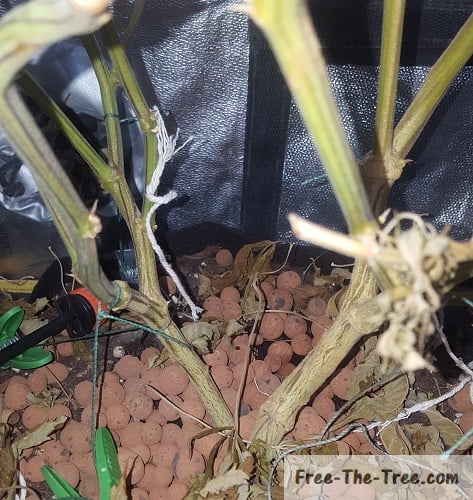
V Stem used as base for SCROG
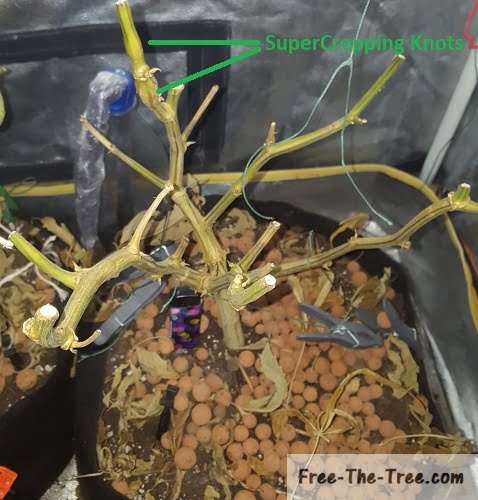
2nd Scrogged Big Budha Cheese Plant
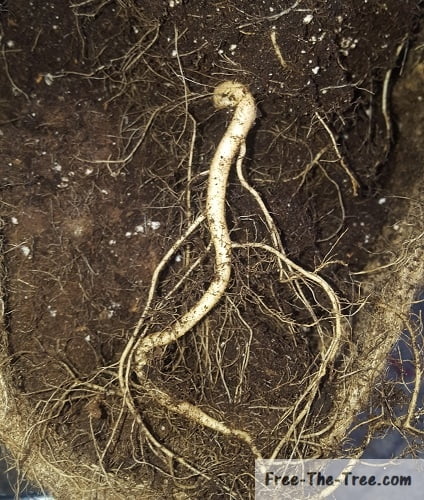
Main tap root (yeah, same one that broke the seed shell ^^)
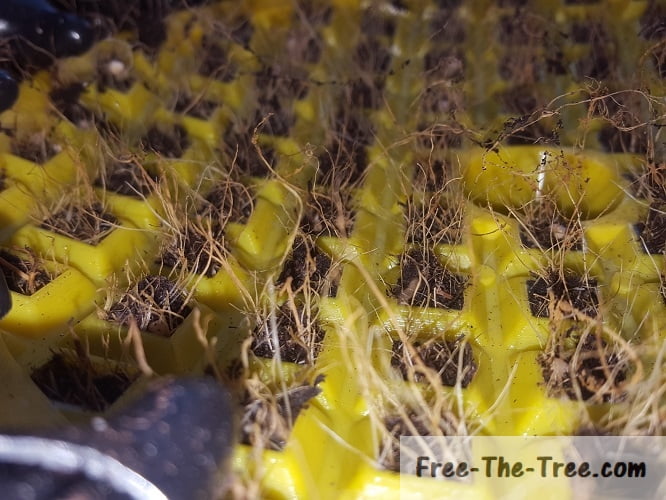
Naturally pruned roots at the base of the Air pot
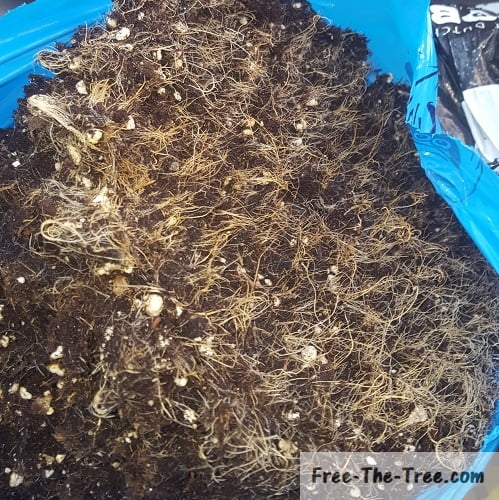
Root system developed when using an air pot
Aren’t the root systems awesome? Between the thick tap root and the thousands of mini roots, no wonder they kept producing sap even days after harvest.
The Blue Kush had even grown so much into the fabric bag that it tore when we tried removing the soil, crazy ^^
Seeing this I definitely see why it’s an issue to be using plastic pots, and definitely won’t ever be using them again.
Drying and Curing the buds
Now that all our plants are harvested and pruned we’ve done about half the work, the most crucial steps of the whole process still lie ahead.. Drying and (especially) Curing your buds.
We did a whole article over here if you want all the details, here we’ll mostly just show you the pics of this round’s drying and curing, since we had a bit more than we could handle we had to get inventive ^^

Cheese and Big Buddha Cheese buds drying in cupboard
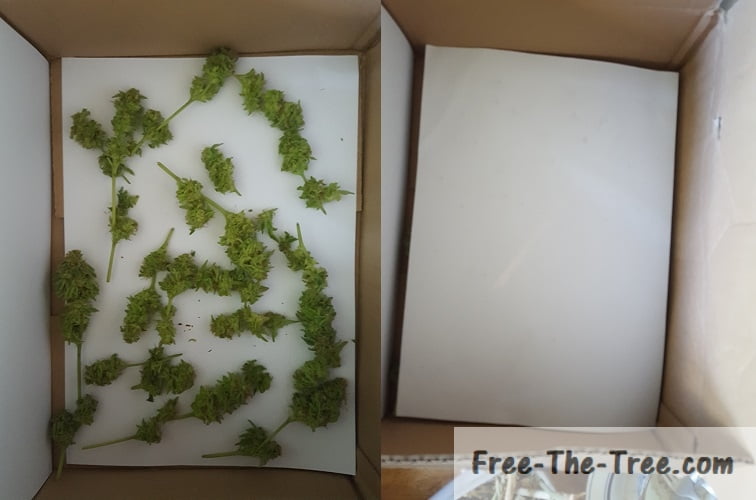
Buds drying between sheets of paper in a cardboard box
If you can, definitely avoid the cardboard box solution, the buds at the bottom may finish flattened due to the weight of the buds on top. If you must go for this, rotate regularly the layers of buds.
The important here is to keep your buds in a dark and dry space. Personally I do this until your hear a little crack when bending the stem, at which point they go into some jars to start the curing process 🙂
Key points during the drying process:
- Keep your buds in a dark area; Light will attack the trichomes
- Keep the buds in a dry space.
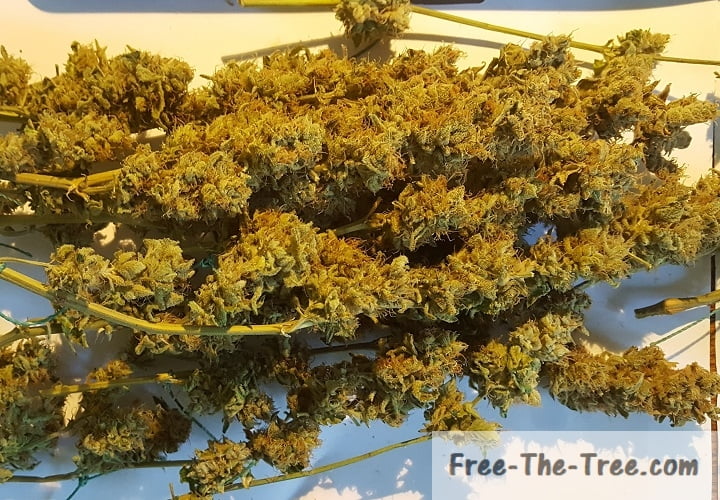
Buds done drying – Ready to weight and cure
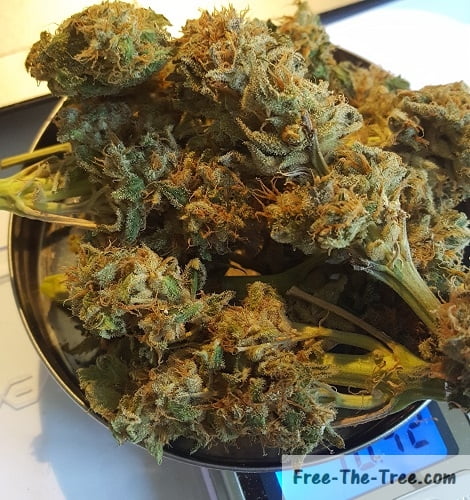
Blue Thai buds on the scale
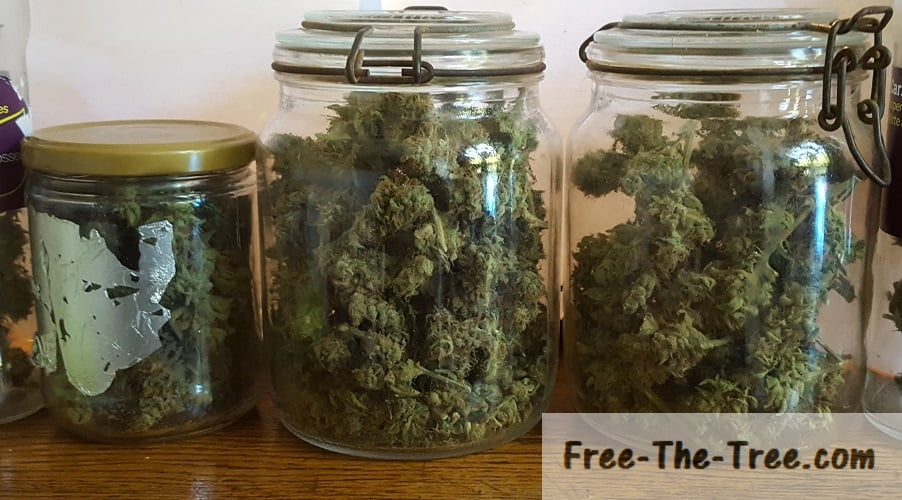
3 of the Big Buddha Cheese jars
Now that your buds are in the jars the process is almost over!
The flowers should still be pretty humid, so for the next 2 weeks you’ll want to open them at least a half hour a day.
Once they start to be crispy, you can add a humidifying packet (~50% humidity) and open them every other day or so.
Key points during the curing process:
- While the buds are still humid, open the jars regularly.
- Store in a dark area. Just as it’s true during the drying process, light will attack trichomes.
- Regularly rotate the buds inside the jar. Since the ones on top will dry faster, you’ll want to even it out.
- Curing can go from 2 weeks to 2 years, just like wine taste and smell will improve with time.
If you go for a long term cure, remember to add humidifying packets. if you don’t the buds will be so dry that they break like dust.
Before we wrap up this final grow report of the series we wanted to go over the main teachings that came to our mind while writing this piece, so here we go
Key Teachings of this Grow
- You must nurture your soil
We all agree that trashing your soil every other grow isn’t a long term solution. That said, plants suck out all nutrients from the soil and the nutrients that are given generally only contain NPK, whereas the plant actually needs over 20 macro and micro nutrients which got us thinking.. how do we get this working long term?
After a bunch of research we found alfalfa and nettle manure which feeds the soil with all these nutrients. That discovered, we decided to plant a bunch out side and start making our own to regenerate our soil, we’ll keep you posted! 🙂 - Thrips are a bitch
Yeah, these suckers followed us since the end of last grow, throughout this one, and we still have signs in the next one.
If you have signs of these suckers, nuc’em!!! - Keeping a flat canopy is key
If you’ve been following this grow you’ve seen that since the stretch our canopy is far from even, and as you saw, especially with the Blue Kush and Blue Thai, this had a very significant impact on the final yield of each plant. - Don’t wait too long to harvest!!
By waiting too long the trichomes start to deteriorate too much and the THC&CBD levels actually go way down. I think we weren’t too far from that with the Big Buddha Cheese - Super Cropping seems to work very well
Alright folks that’s it for this one!
Hope you enjoyed the last post of this series, see you soon with the first months worth of the our 3 Blue Kush’s and 1 Critical plants that are currently nearing the stretch 🙂
Until next time,
be safe and grow easy
Hey guys and welcome (back) to our latest grow report!
For the past couple days the buds of the critical+ 2.0 plants have been growing more and more and the first trichomes have started to show! Exciting times.
The white marks on the leaves have also been spreading across the different plants. We believe it’s spider mites or thrips infestation but still unsure.. We’ll cover that is a separate post but in the mean time if you’re wondering how to see the difference check out our article on the subject.
Let’s get into it!
Critical+ 2.0 Buds Growing
Between day 40 and 45 the buds of these marijuana strains totally transformed. Whether it is on the Critical+ 2.0 or the Flower strain, we’ve seen some strong growth. We decided to divided the evolution of both strains in 2 articles, the second one is coming soon 😉
Critical+ 2.0 Autoflowering Bud evolution
The 2 critical plants are looking pretty good although one of them is the one being invaded by whatever pest we’ve been dealing with which is most likely hurting it. If you’ve been following us you’re aware that the flowering stage started without us wanting us to, but we’re actually pretty happily surprised by a couple of the plants.
Let’s look at the evolution of these 2 plants, remember that you can click on the images to see them better and in a row
Day 40 – Clear Bud Spots
Here’s the start point for this 5 day adventure. Now of course compared to what’s to come they’re nowhere near ready and there’s many steps left within the flowering stage. Once we’ve gone through the whole lifecycle we will group together the pictures in order to see the different steps in image
Plant 1
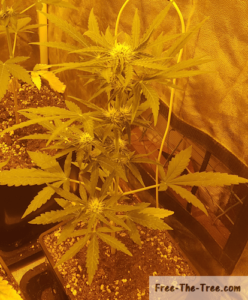
Plant 2
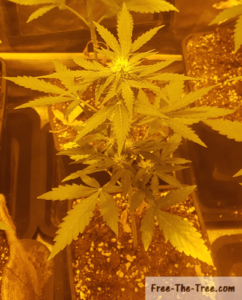
You can see that the buds aren’t at the same stage. The flowers are starting to have a round top on plant 1 whereas plant 2 they’re still in a cone type shape.
We’re also testing 2 different styles of culture here, on plant 1 we decided to keep a couple side branches and plant 2 we are going for a one bud situation (this way to learn more on the different type of culture)
Day 41
Plant 1
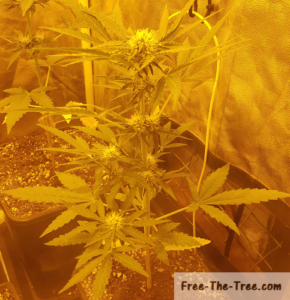
Plant 2
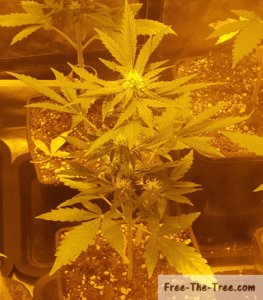
Here’s a focus on the middle stages of the first plant.
Normally these flowers will get big enough to cover the spaces on the stem, creating an illusion of one big fat bud at harvest time. We’ll see if that’s what happens or not
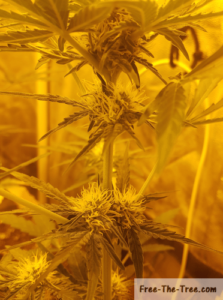
Day 42 – Well developed Apex Buds
Mid way through our journey you can see that the flower on the Apex of the second plant now has rounded up. We basically have a 2/3 day delay the development of both plants.
On her end the first plants main bud is starting to dense up, whereas the bottom buds are starting de develop themselves and will soon start to grow also.
Plant 1
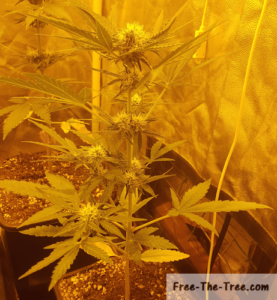
Plant 2
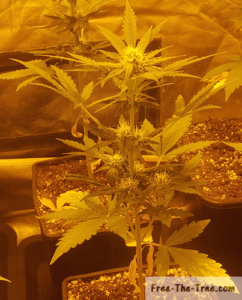
Day 44 – Middle and Branch buds catching up
As you can see 2 days later both flowers on the Apex’s are nice are round and growing more and more. They’ve adopted a cone type shape.
The lower level buds are differently developed, some also share the dome shape especially on the first plant. On the second plant you can see that many of those still have the pistil like shape, these might just have to go, especially the one’s that don’t have direct access to sun light.
Plant 1
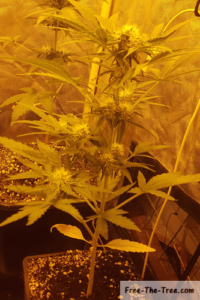
Plant 2
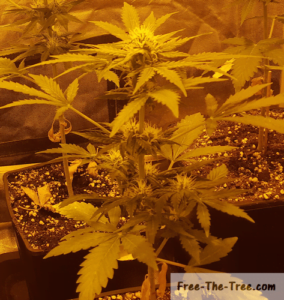
Before we get to the last step of our this journey here’s a horizontal view of these 2 babies (critical plants are the 2 in front)
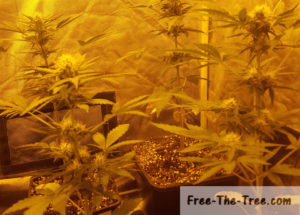
Day 45 – All buds developed
By day 45 the Apex of both plants are domed shape. The Top of First plant is now becoming denser, while the middle and side branch buds are starting to develop a nice amount of trichomes all over the place.
The second plant is still a little behind but they’re getting there. On the upper levels of the plants trichomes are appearing around the buds and on the near leaves,
Plant 1

Plant 2
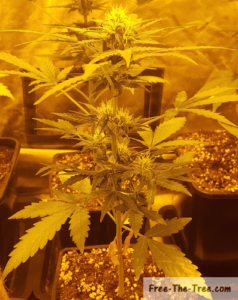
Snapshot of the Buds before and after
Here’s a before/after picture of both plants so that you can easily see the difference in just 5 days
Plant 1 – Day 40

Plant 1 – Day 45

Plant 2 – Day 40

Plant 2 – Day 45

Crazy no? In just 5 days the flowers are unrecognisable, and this is just the start! We’ve come many more steps to go before they’re ready to be harvested and cured. We’ll be covering it all soon
Until next time, be safe and grow easy!
Looking for answers on Indoor Growing?
Check out all our articles
First time here? Check out all our Grow Reports
Hey everyone, hope everything’s going good. On our end we had a bad surprise after transplanting these babies… They started flowering…
Now, if you’ve been following you see how tall they are right? You’ll agree that we definitely needed more time in the vegetative stage. This got us going with deficiencies and possible light burn, still not sure.
Let’s get into these past couple days. Unfortunately I don’t have any pics for day 26, so we’ll start on day 27.
Here’s what we are going to cover:
- Day 27 – Deficiencies and First signs of the flowering stage
- Day 29 – Watering the Critical + 2.0
- Day 30 – Transplanting the last plants
Day 27 – Deficiencies and First signs of the flowering stage
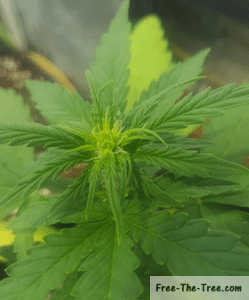


On these pictures you can clearly see a couple issues.. Let’s decrypt them together.
On the one on the left you can start seeing the first pistils of the flower showing up on the Apex. These one’s are much less advanced than the one’s visible on the article’s main image, but nonetheless you can see the starting to sprout up.
Within the middle picture you can see than most of our plants are showing signs of deficiencies. As we started suspecting during the previous days, this is most likely Nitrogen Deficiency.
It would make even more sense due to the fact that they are entering the stretch phase, time at which the plant consumes a large amount of Nitrogen in order to grow.
This means that the next watering definitely needs a good amount of Nitrogen, especially since the cannabis plant stop intaking Nitrogen after the Stretch.
I might actually have to pulverise some on the leafs one of these nights.
On the last image you can see the leafs facing upwards. This is a sign that our lights are too close and need to be brought up.
Light burn can do a lot of harm to your plants, even ruin your harvest! So be careful and make sure you have at least 25cm (10inch.) between the light and the Apex’s of the plants.
If you’re wondering why these plants started to flower without a shift if photoperiods here’s the quick answer, we’ll put a link below to our article if you want to know more.
Since these plants are auto-flowering plants they don’t depend on photoperiods in order to get into the flowering stage, so what do they depend on?
Auto-flowering plants start the flowering stage when the main roots have hit bottom. Meaning that when the main root cannot go deeper, the plant will start going into the stretch phase.
Don’t make the mistake I made and pot your auto-flowering seeds directly into your final pots. That way you’re sure they won’t flower early
Day 29 – Time to Water the Critical+ 2.0

Here we are again to a watering time. Now if you look well you can see that not all the plants are showing signs of thirst. I suspect this is our fault, after the transplantation we must have watered some plants more than others.
The other possibility is root development. If the root system of these plants isn’t as developed as their sisters than they cannot access what they need within the new soil. Meaning that the humidity is there, she just can’t get it.
You can also see that the deficiencies have continued to spread across the leafs, showing that we haven’t fixed the issue yet..
It might be due to the fact that they haven’t taken in the nutrients yet, so we’re going to have to wait it out, or else we might go from nutrient deficiencies to nutrient burn.
Apart from that, it’s really time for our 2 last plants to be transplanted, it’s been almost a week since the 4 others are in their new pots, if we wait too much longer we’re going to have problems with them, and they’re are best one’s out of the bunch so that really would suck
Day 30 – Transplanting the last Critical + 2.0 Marijuana plants
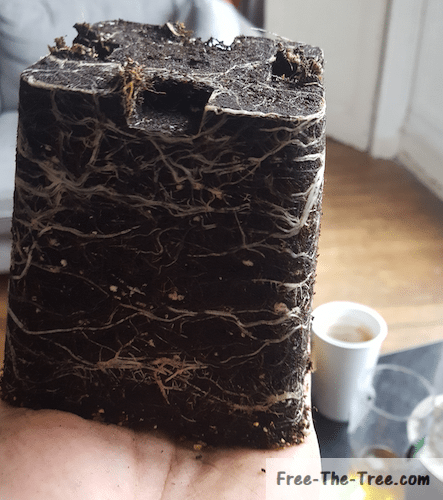
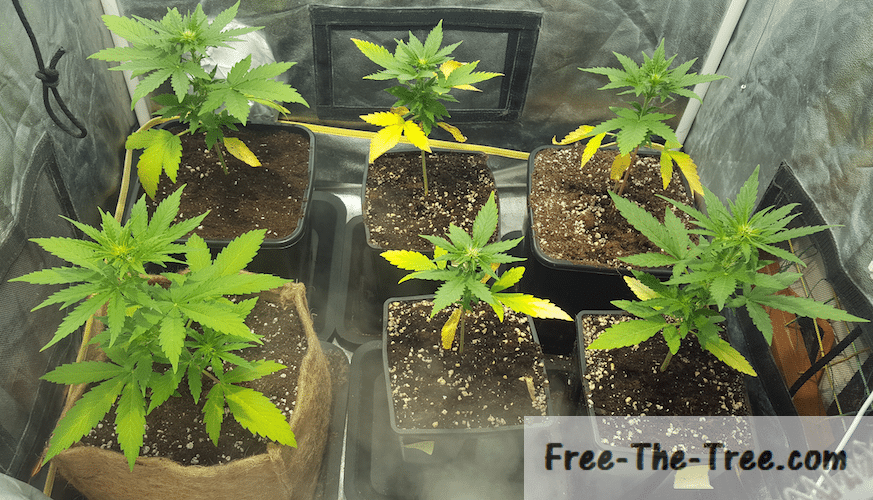
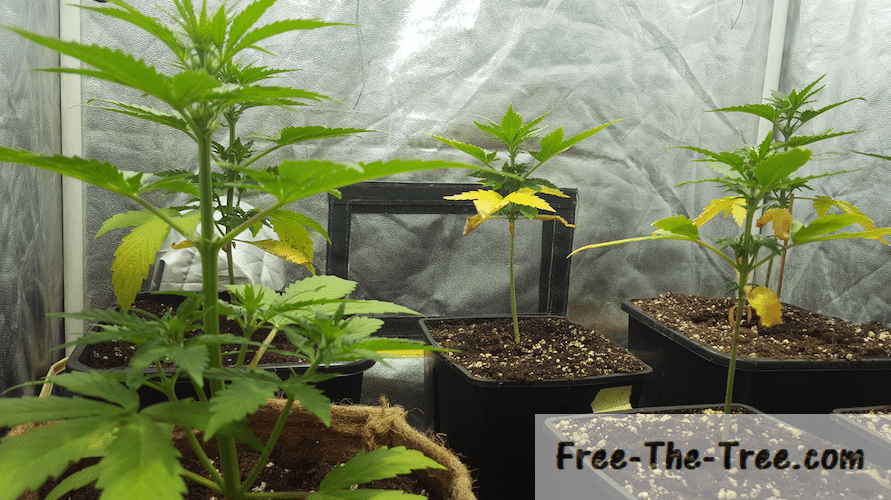
So we finally got these last one’s into their new pots. They weren’t supposed to be their final pots, but since these babies have started to flower I don’t really have a choice here..
You can see on the left picture that they had well invaded the ground. If you look close you can even see some roots starting to exit what used to be the bottom wholes of the pot. This is definitely a sign that I should of transplanted earlier.
In the middle picture you can see that our issues just keep going, have some leafs starting to go white on the tips, other already dead, it’s just not looking good.
On top of adding some more Nitrogen during the last watering, I started to add so P and K (Phosphorous and Potassium) as well as raised the light a bit.
Hopefully that will do it will stop spreading.. the one’s the most hurt are the one’s with the less leaf mass which is a big problem, their going to concentrate of leaf growth during the flowering stage, where we want them to be growing some fat buds.
On the last picture you can clearly see the differences in our late plant vs the earlier one’s. The earlier ones have week stems, their first stage is much higher off the ground and they have much less branches and stages.
It’s crazy how a small difference during the first 2 days of their lives can make such a big difference later on.
Now you might also be wondering what that brown looking thing is. It’s actually an “eco pot”, made out of organic material.
A friend gave it to me and we’re testing it, it’s supposed to be better for the roots since they can grow into the sides of the “pot” instead of being stuck to the sides of the plastic one’s. We’ll see how it goes.
That’s it for this one folks! In the next post we’ll start talking about cutting your branches and leafs in order to keep just what you need
Until then, don’t hesitate to give feedback on this post, or if you’ve had similar situations, we’d love to hear about it.
Be safe and grow easy!
Hey there !
Wish we were writing this post on a happier subject… But for the past couple months we’ve been battling a spidermite invasion, and what a battle it’s been !
The infestation started in our little garden, on our tomatoes to be specific, but with time these suckers spread… Outside they got to our a bunch of our plants and while we were busy raising money for citizen lobbying tool these suckers got to our flowering tent…
Let’s go over this whole o’deal together 😉
Excuse us for not having the best quality pics available on this post, our camera broke and we haven’t been able to replace it yet
The first signs of Spider Mites…
As you’re most likely aware, spidermites reveal their presence by leaving little white spots on the leaves. If you’re seeing this, ACT NOW, the earlier you start fighting back the infestation the better your chances are.
On our end when we noticed we had just gotten back from vacation so the infestation was already massive.
The image below shows a couple leaves totally infested. The plant was over 4 feet tall, just imagine how many individuals were on there..

Every red dot… is an adult spidermite
Our first strike – Black Soap & Neem oil Combo
Since we already had dealt with a thrips invasion during our previous grow (yeah, we’re not lucky), we already had black soap and neem oil around.
These 2 ingredients work just as well as on Spidermites as they do on thrips, on paper. As we cover in our guide on how to deal with spidermites, the importance here is coverage, coverage, coverage.

Our neem oil & Black soap mix ready we started spraying all the infested plants, making sure to cover as much the top of the leaves and their backside, where the mites lay all their eggs.
The spidermites strike back, viciously
After applying the mix all over the plants, twice, leaving a couple day intervals we had to leave for a couple days again.
When we came back these suckers had come back too, and with a vengeance! Honestly I think there were thousands of them on just this one tomatoes plant.
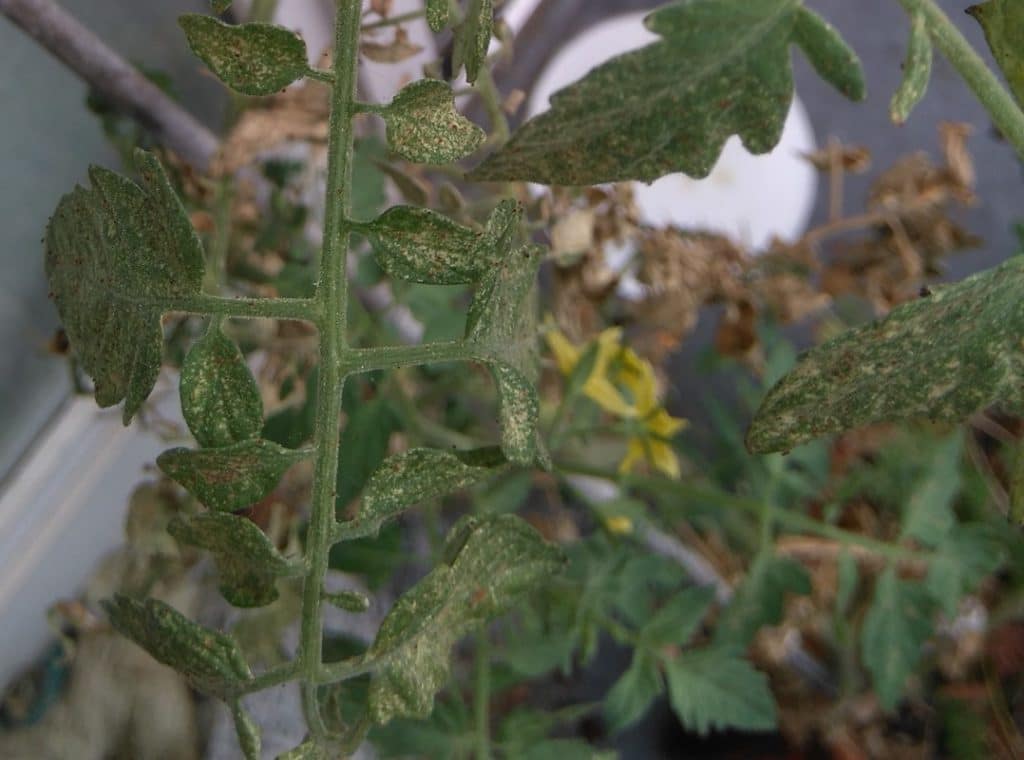
click on the image to get the full view, and again every red dot is an adult spidermite…
At this point it started really impacting the development of the plant with some sections totally dying out (the ongoing drought didn’t help out).
The fruit bearing sections went from 12 flowers to 2/3 per ramification, new growth slowed crazily and older sections started dying out.
Clearly, these pest don’t hesitate to suck the live out their host, literally.
Nature does things well… Investing in Predators
The Neem oil and Black soap mix is effective against the adult mites but I’m not so sure about their eggs, and since they can lay up to 20 of them a day, the adults are really just the visible part of the iceberg.
That’s where investing in a predator is useful, in our case we’re talking about the Phytoseiulus Persimilis, which feeds exclusively on spidermites and their eggs !
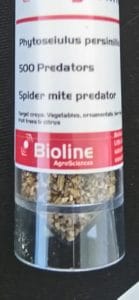
The number of individuals you want to get will depend on the size of your infestation, on our end with 500 we clearly under did it since we had about 6 infested plants by the time they got here.
As we point our in-depth article on spidermites, linked above, applying a round of neem oil & black soap mix a day before introducing the predators.
In doing so you will reduce the number of pests drastically, and then the predators will swoop in to finish the rest of the adults and eggs that are still around.
Not enough predators, the mites spread to the Cannabis plants
By now it’s been over 2 months since the first signs of the pest and they started infesting the flowering plant mid-way through the flowering phase.
The worst part, we were in the middle of the crowdfunding campaign with United4Earth so let’s just say that we weren’t the most attentive to our babies at that moment…
The mites had fully infested our Blue Kush by the time we even realized they were around.
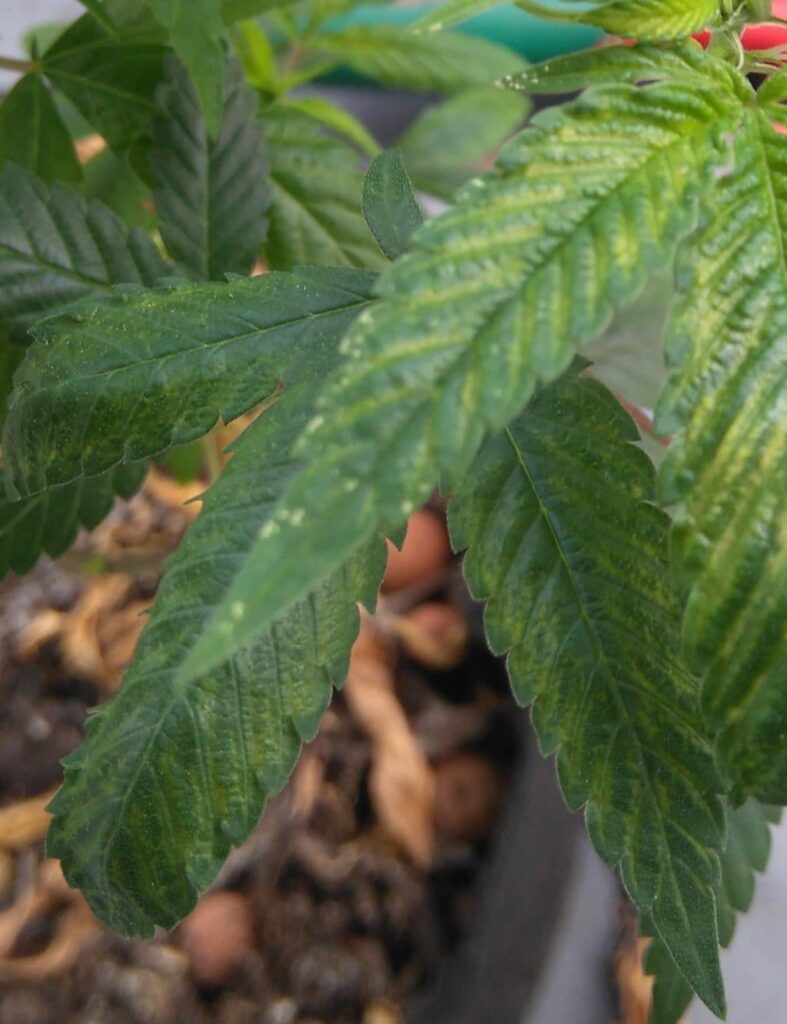
First white marks appearing on cannabis leaves
As you can imagine, we were unhappy of this discovery, to say the least. Here we were, back preparing a mix and ordering some predators, again…
Since we were in the flowering phase we just used the Neem oil the first time, as ingesting it can get you sick, so we didn’t want it all over the buds we were going to smoke.
A very weak harvest..
Every couple days we kept spraying the foliage, but there was so much damage done that we decided to go ahead and harvest, clean the room before placing the rooted clones into the flowering tent.
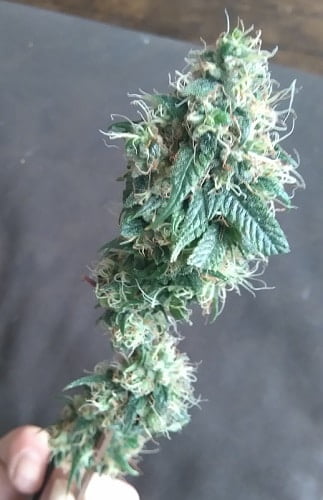
Critical + Apex bud freshly harvested and pruned
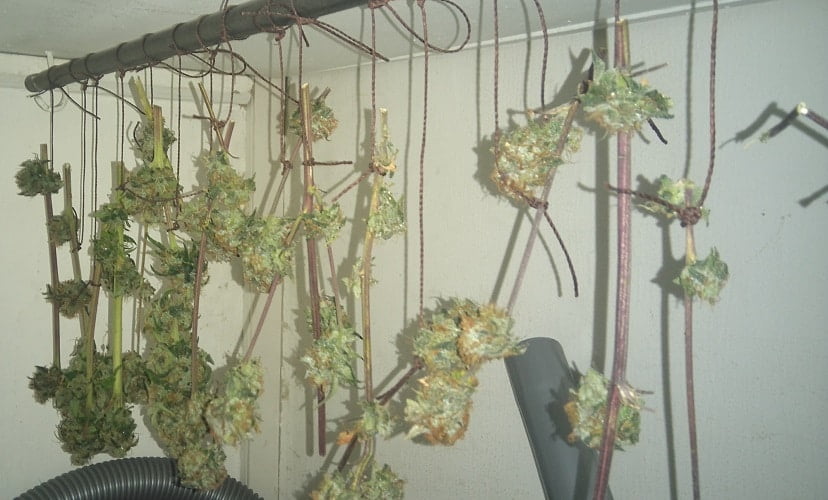
2 plants drying – Super small harvest
Just as we saw with the tomatoes, since the plants were battling for survival, the amount of flowers produced was severely impacted. We haven’t weighed it out yet but i’m thinking it lost us at least 50% of the harvest..
Hopefully our in-depth clean of the grow room got rid of the last suckers, but just in case we still have that batch of predators that should be arriving soon. We will introduce them in the grow room regardless so that they can go hunt for eggs.
We don’t wand to get a surprise in a couple months when the ones laying around start hatching.
That’s it for this one ! Hopefully this will be our last post regarding spidermites (and thrips)
We’ve decided to start posting an article every friday from now on, so until next week,
Be safe and grow easy!
Hey guys and welcome (back) to Free The Tree!
This week is pretty weird. On one hand we’ve got 2 plants that are growing real quickly (the 2 BBC’s) and 2 plants growing reeeal slow (cheese and Blue Thai). We’re already trying to figure out how we’re going to deal with the different sizes in time in order to avoid issues during the flowering.
That said, in this post well go over the plant training that we did in order to prepare for the SCROG, as well as the reasons why these two little one’s have been growing slowly.
Let’s get into it!
Training Marijuana Plants for ScrOG
Setting up your ScrOG is something you need to prepare for pretty early on in the life of your little one. I’m not saying that you can’t decide later on, but the best moment to start training your plant is at the 3rd stage of leaves.
Little pointer before we get into it, we won’t have the last step on the training since it takes a little more than a week to grow. The last step will be in our next post 😉
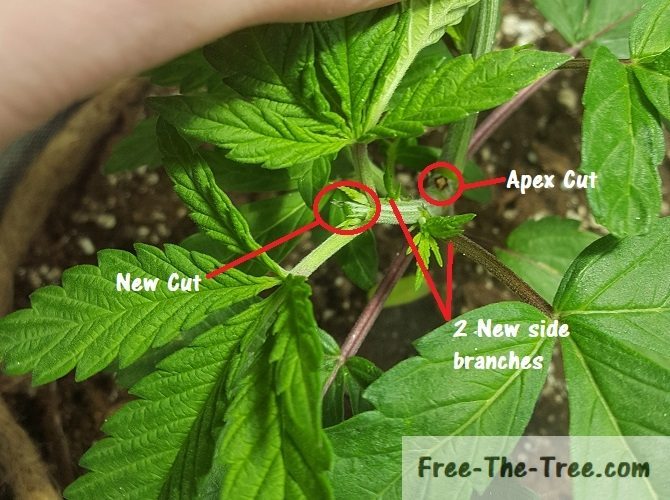
Training Weed for a Scrog Easily
So we’re going to go through each step in order to train your Marijuana for a scrog.
As a reminder, these are the steps before setting up your screen. If you want to go to the screen set-up check out our ScrOG guide.
The first picture will show the plant just before we started to train her, after which we’ll get into each step.
Plant 1 – Young Blue Kush Weed Plant

You want to wait until the 3rd stage of leaves before doing anything. In the picture above we must wait a little before starting to train this one.
Step 1 – Pruning the Apex
Once your plant has grown her 3rd stage you’re going to want to cut (prune) the top section of the plant with a pair of clean scissors or a blade.
As we show in the picture below, you’ll want to do this just above the knot, be careful not to damage the side branches that are forming!
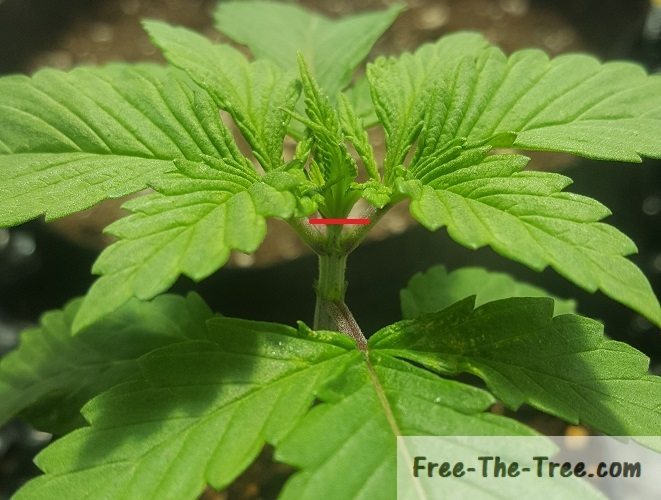
In the next step you will be able to see what it the plant will look like without the Apex. If you’re worried about the fact that the Apex is supposed to be her strongest and best bud, don’t worry, you’ll get that bud x10 😉
Step 2 – Let the 2 new Branches Grow
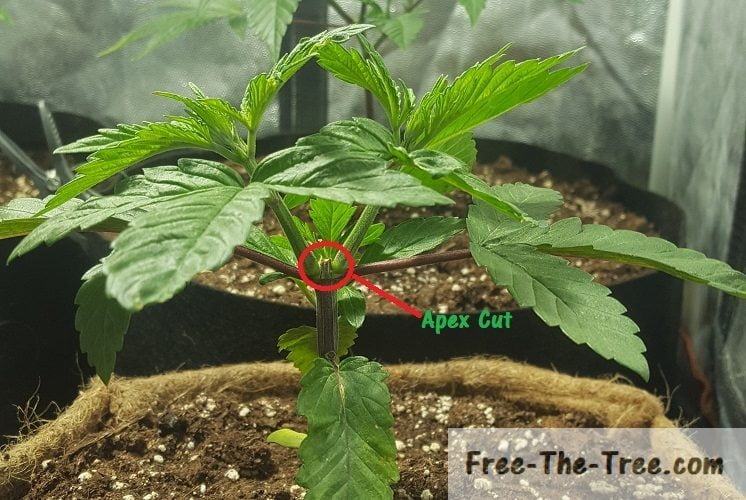
After cutting the Apex you’re going to want to wait until each side branch has developed a new stage of leaves.
Step 3 – Prune Tip of the 2 new branches

Now as you can see we waited a little too long to cut the tip of the side branches. Generally you’d want to cut it before the growth of the next stage in order to avoid any waste of energy. With that in mind, we’re still going to keep the 1st stage branches, in time we’ll prune the 2nd stage growths and that top leaf that’s shading the branch.
Step 4 – Let the new sets of branches grow

Once you reached this stage you’re going to wait a little until those 4 branches have grown enough to start training them. As you can see above, at this point in time they’re way to small to start doing so. We need to wait a couple days, so the second half of this section will be on the next post 😉
Slow Growth during the early Vegetative Stage
As we started saying in the beginning of the article, 2 out of the 3 plants originating from the germinated seeds have been growing really slowly, especially compared to the third.
After reading left and right, this is due to the fact that we planted them straight into the final pot, whereas the other plant was in a small pot before being transplanted into the final one.
We didn’t know this at first, but a weed plant in that it in a pot that’s too big for it will grow much slower since it’s focusing on root development. This means that the root system will be well developed, but there’s definitely some time lost.
Here’s a couple picture of the growth during this week.
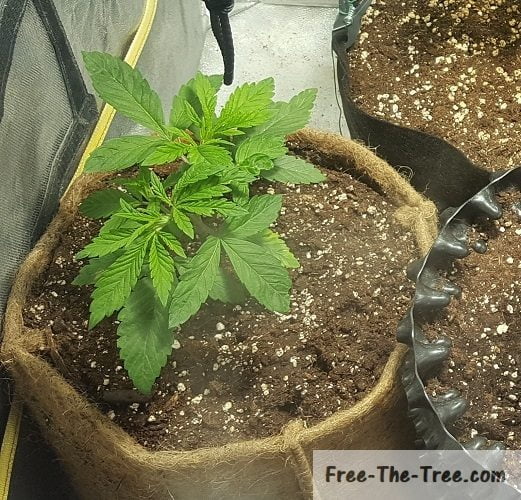
Normal Growth – Blue Kush planted in small pot than transplanted to larger pots.
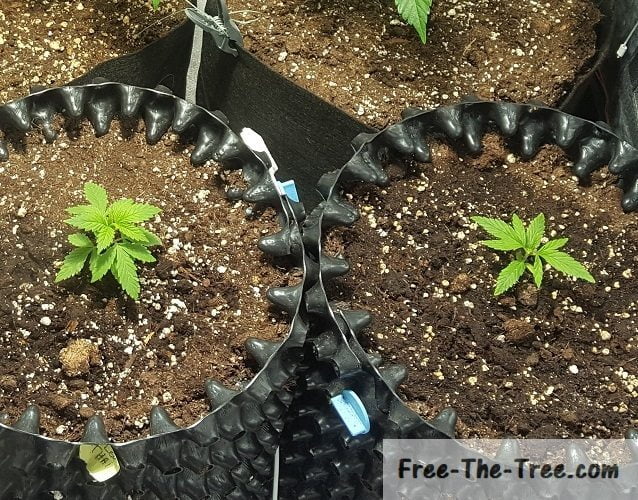
Slow Growth – Blue Thai and Cheese planted straight into the large pots.
Just with these 2 pictures you can easily see the huge difference. Keep in mind that these seeds germinated at about the same time! (couple days delay for the Cheese plant on the far right).
Crazy how big of a difference in growth there is no? Thankfully this week the 2 slower plants started getting there growing on, but they’ll never catch up the other plants.
As we said earlier, the reason for this is the fact that a marijuana plant that’s planted in a large pot will grow slower during the early vegetative stage.
On the upside, these plants won’t have any transplanting stress and once the root system is well developed they’ll get growing strongly.

Blue Thai – Apex just pruned for ScrOG preperation
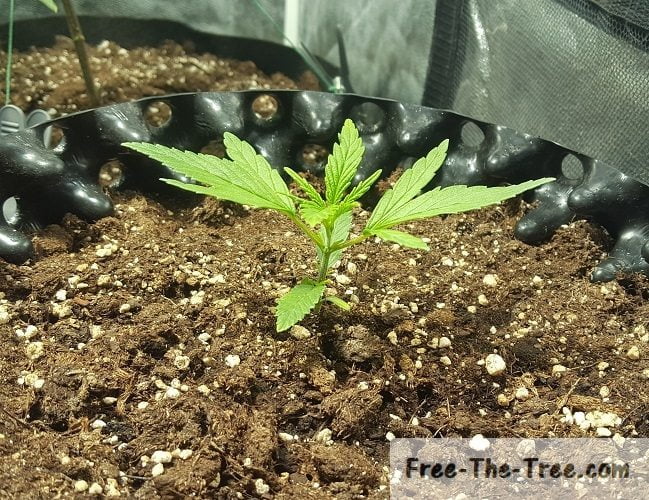
Cheese plant event smaller – 2nd stage of leaf growing
As you can see in the two images above, by the end of the second week they had grown “a lot”. The Blue Thai had grown the 3rd level of leaves so we decided to cut the Apex on this one.
On her side, the Cheese is still hanging back. We decided to cut all new side branches in order for her to focus on vertical growth.
I’m not too sure what we’re going to do with her, if she catches up we might do a small scrog, or else we’ll just keep a couple side branches and work her more when we get into the re-vegetation cycle (spoiler ^^).
Before we let you go, here’s a couple last pictures of them at the end of week 5, as always click on them to see the full picture.
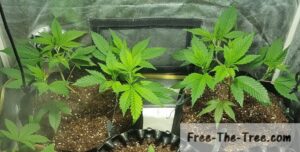
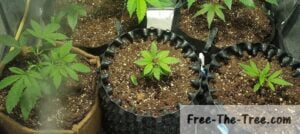
Hopefully these 2 little ones are going to get their grow on.. Next week we plant to make the cutting of the Blue Kush for a friend and place the screen, so they need to hurry up ^^
Alright Folks, that’s it for this one.
Until next time, be safe and grow easy!
Don’t want to go yet? Check out our other Grow Reports
Check out all our Indoor Growing Tips
Going through all these balance issues with 2 of our plants we decided to do a quick piece on balance issues with marijuana plants during the early vegetative stage. Hopefully this will help some of you that have the same issue, or to avoid having it in the first place.
Here’s what we’re going to cover:
- Why do marijuana plants get balance problems
- How to avoid balance problems during the early growth
- How to fix balance problems
Why does Marijuana get balance issues
Generally a plant gets a balance problem when the direction of the light source pushes it to grow in an un-natural fashion. Either too fast, or at an angle that it cannot sustain in the long run.
This can be generated by:
- A light source to far from it’s Apex: The plant will grow so tall the stem won’t be able to hold the weight of the top anymore.
- A light source too far to the side. Try to keep your light source as centered as possible to all your plants. If you can’t then get it a little closer (without giving them light burn)
In our case, during its very early growth the light we used was too far from them and not strong enough.
The 2 earliest sprouts just grew straight up to get as much light as they needed.
Once they we’re tall enough they started growing leaf mass, but its weak stem cannot hold all that weight, and after a little growth the plant falls over.
Now, plants are pretty well built, she will adapt in order to face the light source, but we will all agree that a horizontal stem isn’t the most optimal for a plant. You can see this right here on the picture. Found her like that one day, she had fallin over and stayed that way a couple hours so she adapted, facing up.
Lets get to how to avoid these situations early on, and then how to fix it.


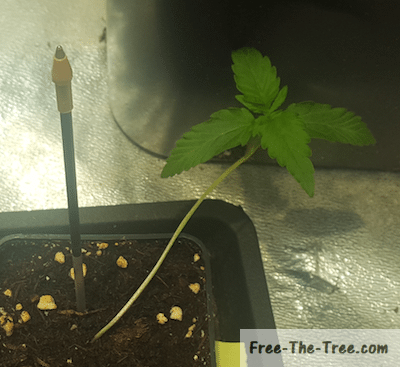
How to avoid balance issues during the early vegetative stage
As we said earlier, the Cannabis plant will have issues with balance if the light source isn’t strong enough or not aligned with the plant. Here are our tips to avoid these issues all together:
- If you don’t have your sprouts in your grow room during the first 2/3 days after sprouting, keep the light source about 15/20cm (6 inch.) over the apex of the plants
- Get your plants in the grow house tops 3 days after breaking ground or if the sprouts are over 5cm (1.5inch.) high
- Keep your light source aligned with the top of your plants. If your using desk lights, add a second light source
Just by getting your plants into your grow room quickly you can avoid any issues, here’s an example between 2 of our plant that had the same conditions, except one of them spent much more time out of the grow house after breaking the ground than the other.
On the left you will see the one that broke ground earlier, the one on the right broke ground about 2 days later.
Day 2 – I need light!!

You can see the she’s been focusing on growing high in order to reach for the light source. You’d think this is cool to get a nice big plant, but at this point it’s not really what you want, you want leaf mass.
Day 0 – Hello World!

This little one’s just coming out of the ground and discovering the world. Her 5 sisters have been out for a while now, this is really the late bloomer of the batch.
Day 4 – All the light I need, lets get some leaf
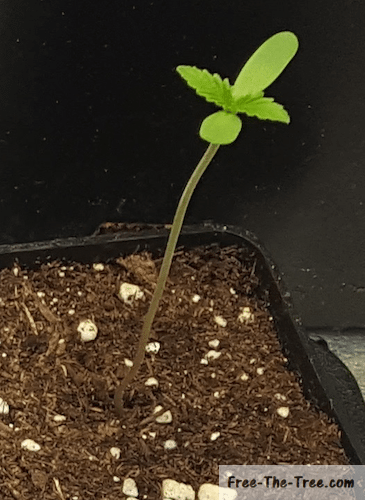
By day 4 of this early bloomers life they were in the grow house. This one is the first that broke and the tallest out of them all.
Growing in height got her late in leaf production, which isn’t really the best thing here, especially that these are auto-flowering seeds so there’s no control over the length of the vegetative stage
Day 2 – Ah in the grow house with some nice lighting

The entry into the grow house was on day 2 for this one, you can see that appart from a little burn to the new leafs due to the change in lighting being so abrupt. I should of eased her into the new environment by doing a 12 hours in/12 hours out of the grow house during the first days.
Apart from that it’s all going great for this little one
Day 8 – Top heavy and falling over

The entry into the grow house was on day 2 for this one, you can see that appart from a little burn to the new leafs due to the change in lighting being so abrupt. I should of eased her into the new environment by doing a 12 hours in/12 hours out of the grow house during the first days.
Apart from that it’s all going great for this little one
Day 6 – Chillin’ and growing leaf mass

The entry into the grow house was on day 2 for this one, you can see that appart from a little burn to the new leafs due to the change in lighting being so abrupt. I should of eased her into the new environment by doing a 12 hours in/12 hours out of the grow house during the first days.
Apart from that it’s all going great for this little one
Day 10 – Starting to stabilise and growing
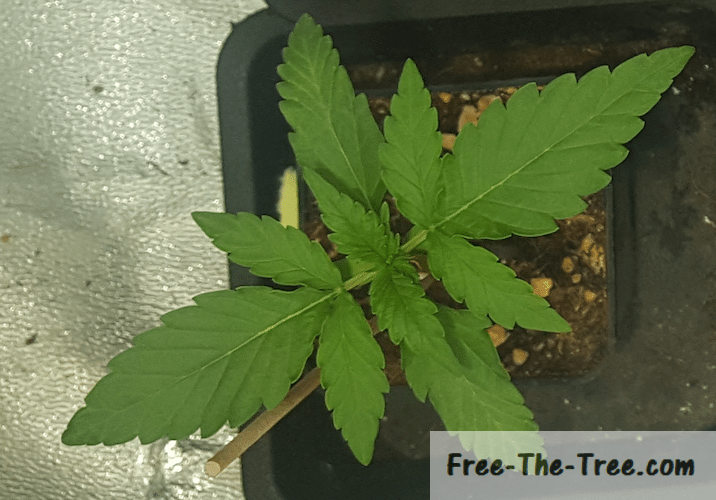
By the 10th day you can see that she’s pretty much stabilise, although she still can hold up on her own.
Soon enough she’ll be holding up just fine, although all of this will have used up some energy!
Day 8 – Growing 3rd stage of leafs
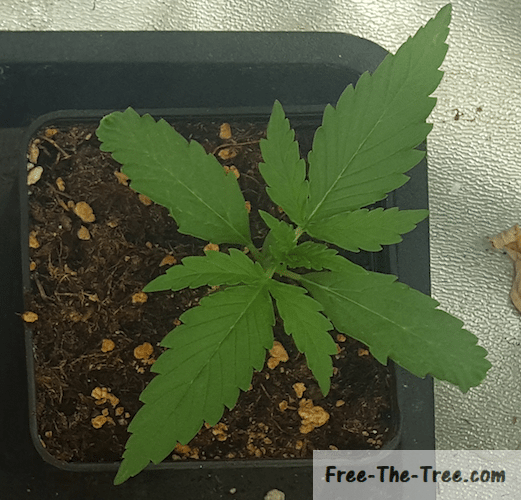
You can see that by day 8 this plant almost looks like the one from day 10, why’s this? She didn’t have to waste any energy on growing up vertically, so she’s shorter but already has a strong source of energy to get her growth going!
I’ve got a feeling this one will be the diamond of the batch
Day 14 – Tall and now Balanced

By Day 14, the plant had finally gotten strong enough to hold on their own. I’m still leaving the stakes in just in case but I’m going to get them out of there real soon.
I’ve got the fan blowing on them for the past couple days which got the stem to start strengthening which is a good sign
Day 12 – Short but growing strong
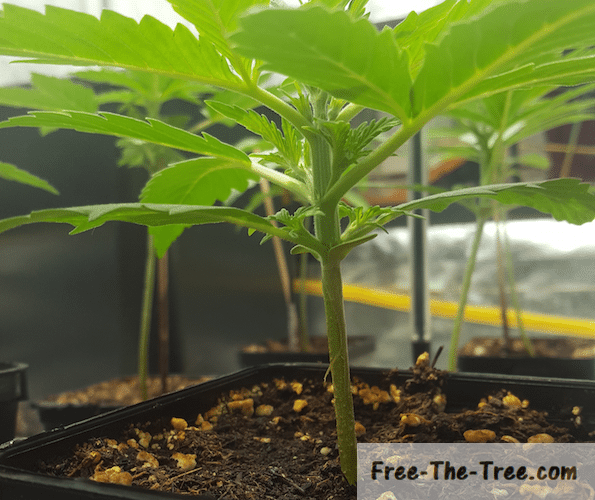
This one’s just nice, she’s short, with some very tight knots which is a good sign to get a nice and dense plant. She’s short but her stem is already nice and strong, much wider than her sisters. The 3rd stage of leafs is already growing! Kind of confirming the idea that this will be the nicest one of the batch (don’t want to jinx it though ^^)
As you can see, just a difference within the first 2 days of growth you can have a strong impact on the early days of the vegetative stage, so it’s important to be careful as soon as you get your seeds going.
Lets get into how to fixe balance issues
How to fix Marijuana balance issues
Here you have 2 objectives:
- Keep the stem as straight as possible
- Get the stem stronger so that it can hold itself up
Let’s go over the ways to accomplish these objectives
Keeping the Marijuana stem upright
- Get a long piece of wood, it should be at least the height of your stem, if not a little longer
- Get the stem into the ground near the base.
careful not to brake any roots! - Get the stem to lean onto the wooden stake, allowing her to stand upright
- If need be, get a second stake on the other side of the stem in order to hold her up.
Don’t hesitate to use the leafs to balance the plant out - Get your fan to blow just over the top of the Apex, so that it’s moving a little, this will get your stem to strengthen.
If you can’t because your plant keeps falling, wait until it’s a bit stronger to do this


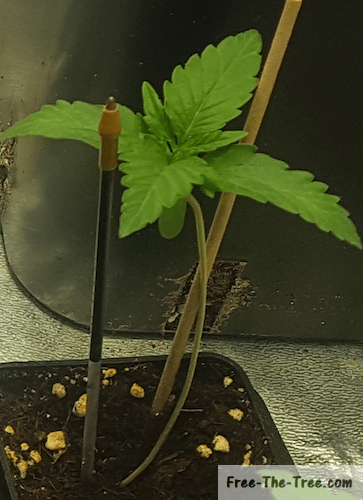
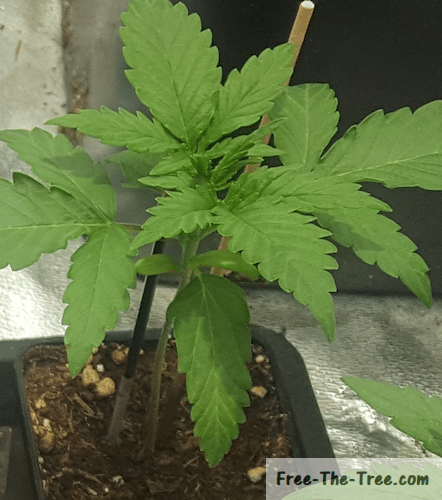
Alright that’s it for this one folks, we’ll be posting about day 15 to 20 of these Critical + 2.0 and fruit babies in the upcoming days,
Until then, be safe and grow easy!
Hey there and welcome (back) to our growing guide! This has been a turbulent session with these auto-flowering plants, it was our first time with these types, full of learnings! We’ve actually grouped it all together in an in-depth article if you want to know more.
During these couple days so many things happened, we started noticing some weird white marks on a couple leaves of our plants, had to prune some branches and pop-corn buds off and started seeing some nice bud growth getting started.
Before getting into it here’s some pics of the plant during these days, don’t hesitate to clic on them so see the full picture.
Day 36
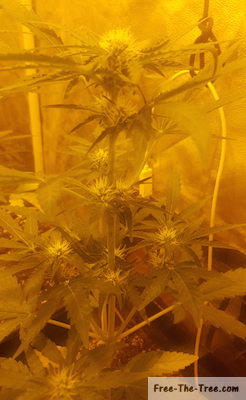
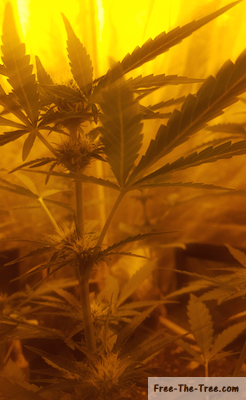
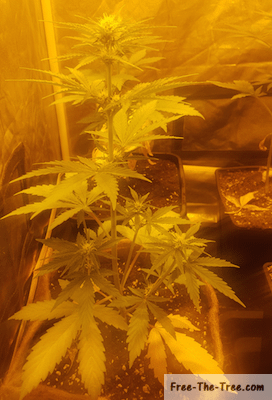
Day 37
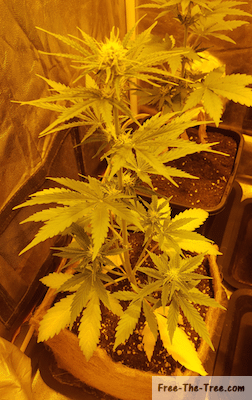
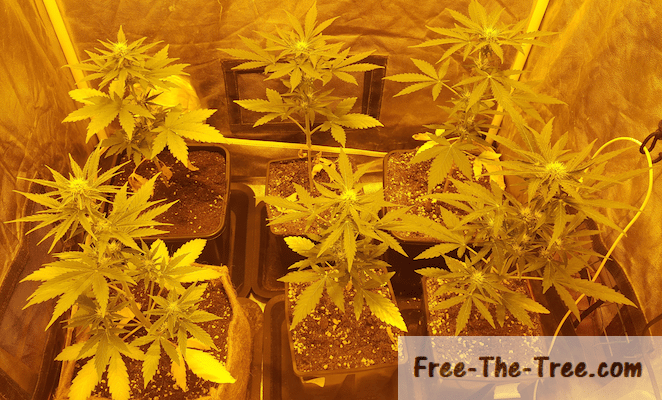
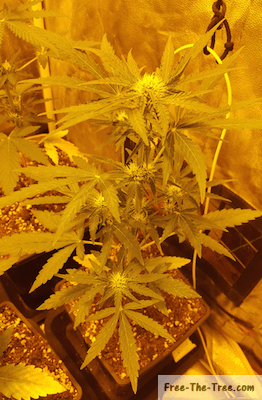
Day 38
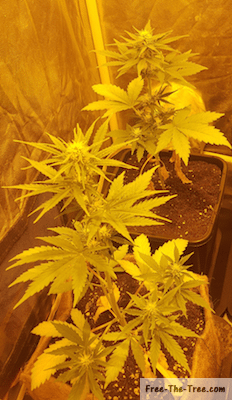
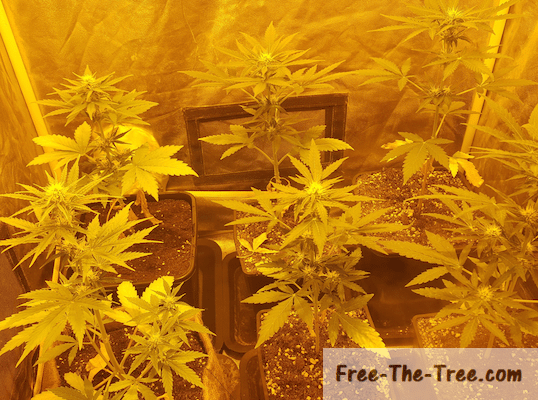
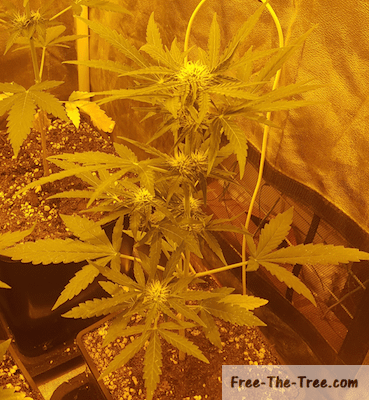
Day 39
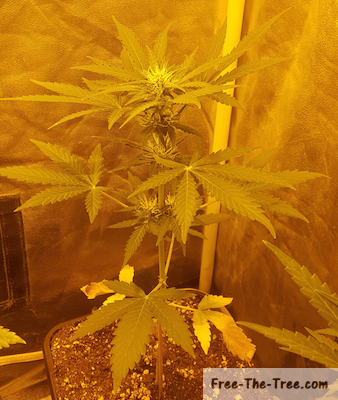
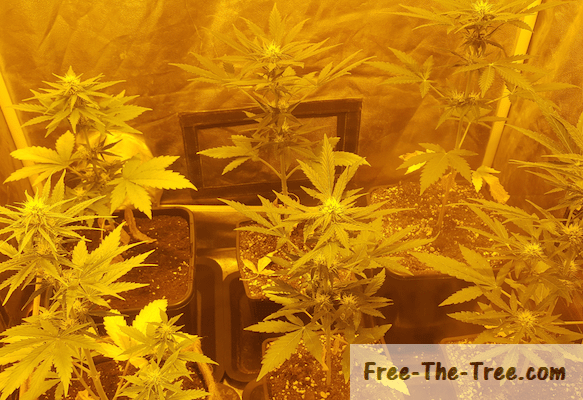
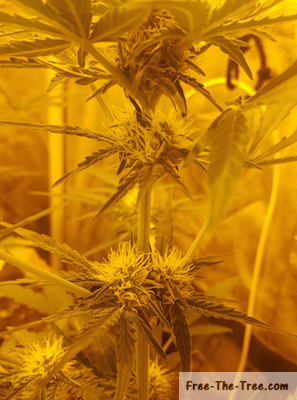
Day 36 – White marks on leaves and pinching the stem
On day 36 two things really went down.
The first concerns pinching the stem of the plant where we are growing multiple side branches (bottom right one). The objective of this is to reduce the amount of nutrients going to the Apex and redirect it to the side flowers.
It should also create a knot on the stem allowing the plant to store more nutrients. This is something that should be done during the flowering stage, but as we said in one of our previous posts these babies started their flowering stage a little early.
The second is that we started noticing some white marks on a couple leaves of one of our Critical+ 2.0 flowers. At that time we though it was some kind of deficiency, just couldn’t believe we had spider mites. We decided to see how would evolved over the next couple days before acting (worst thing to do ever!!); We should of just cut of those leaves right away..
If you want to now more on those little suckers and what they can do to your plant, check out our article on Spider Mites (aka the Tetranychidae Family)
Pinching the stem of Marijuana
As we said earlier, pinching the step of your cannabis plant will:
- Reduce the nutrients brought from the roots to the area after the pinching area
- Increase the nutrients brought to the rest of the plant
- Create a knot allowing her to stop more nutrients
- Should balance out the nutrient distribution on all branches or bud area’s
Here’s more on this
How to pinch the stem of Cannabis
- Identify where to pinch. This will depend on your goal.
- Place your index on one side of the stem and your them on the other
- Squeeze the stem until you fell/hear a clicking noise. You will know it when you feel it.
In our case we wanted to increase the amount of nutrients sent from the roots to the side branches, so we decided to pinch the stem just under the first level of buds.
This does not mean that the top of the plant won’t have any food, remember that plants produce their food through photosynthesis, what comes up from the roots are “just” extra nutrients. Furthermore, nutrients will continue to flow, just not as much.
In case you squeeze way too had and you’ve broken the outer layers of the plant place some tape around it until she fixes herself up.
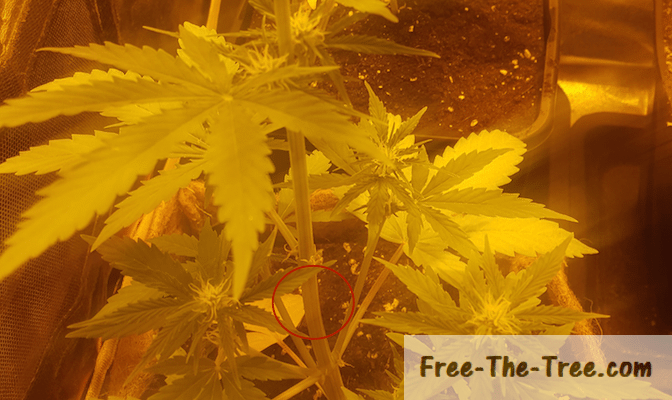
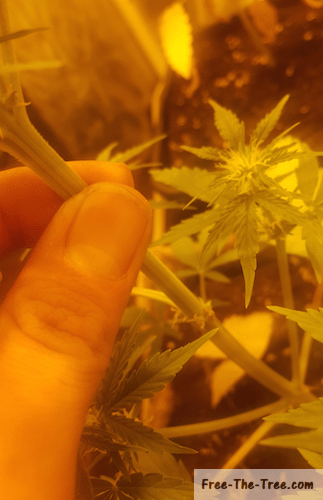
Appearance of White Spots on the leaves
We started noticing that a couple leaves of one of our Critical + 2.0 plant started to have a couple little white marks grouped together on them.
You can see on the images on the right that each leaf has more or less marking on them.. Little did we know but that was the start of our infestation and the leaf with the most marking was the base leaf of it all.
At this point we didn’t really know what it was and thought it was some type of deficiency. As most first people first encountering spider mites.
In that spirit we at the next watering we decided to increase the amount of nutrients given, which didn’t hurt but didn’t help out for the infestation.
To make matters a little worst we also decided to lower humidity levels to about 45% since the flowering stage has begun. As we’ve covered in our guide, spider mites hate humidity and love hot dry weather (which we learned after hand..) so this made matters worst.
Spoiler alert: We were able to survive this but lost a good amount of leaf mass and spend a good amount of energy in management of the infestation. More on that in our next posts 😉

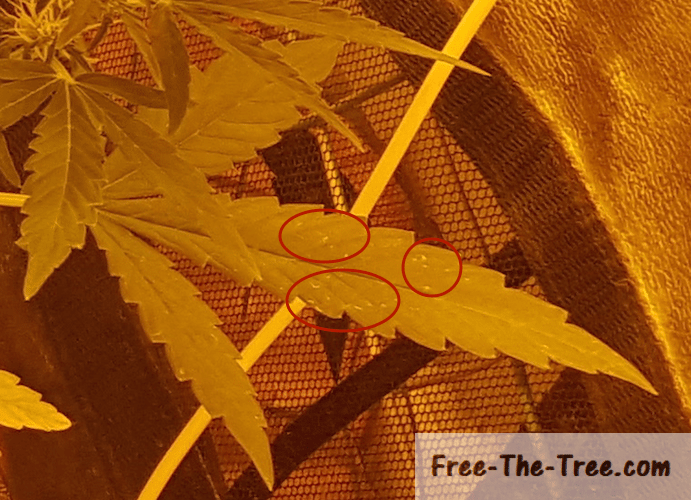
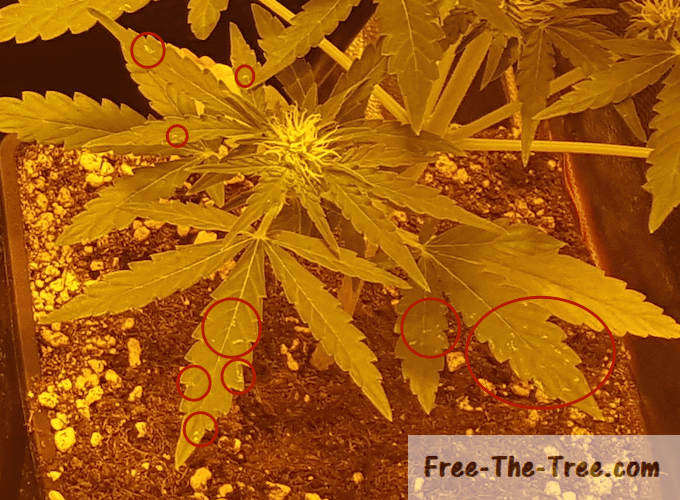
Day 37 – Trimming Pop Corn Buds
Now that our plants have well entered the flowering stage we can identify the bud sites that we want to keep and those that need to go (aka pop corn buds)
This is also the “last” opportunity to cut branches that are not receiving direct light, thus taking energy produced by photosynthesis of other sections of the plant.
What are pop-corn buds?
Basically Pop-corn buds are those small buds growing low of at the middle of your stems.
These area’s will generally produce low quality buds while taking a lot of energy to produce. It is much better to remove these buds in order to keep the energy for the buds higher up on the stem.
The earlier you are able to identify and remove these pop corn buds the more energy your plant will place into your main buds.
You might need to repeat the procedure once or twice if your plant sprouts new bud area’s but this shouldn’t be the case.
What might happen though is that you notice that you’ve missed a couple further down the road, at which point you’ll have to make the call.
Are they going to produce anything worthy or are you getting a blunt or two out of it? In the second case, get her to go.
(if you’re far enough down the line get it drying, it’ll be an early, lower quality taste of your harvest)


How to cut pop corn buds?
- Identify what branches to remove
- Take scissors or a cutter (optional but recommanded)
- Place your fingers or cutter at the base of the flower
- Pinch/Cut off the bud
As you can see this is pretty simple and very similar to removing branches off your marijuana plant. Be careful not to damage the outer layer of the branch or stem.
As you can see in the last picture, by doing this with your fingers the cut isn’t very clean, since a clean cut will heal faster, it’s better to use a blade or scissors in order to trim your marijuana plant.
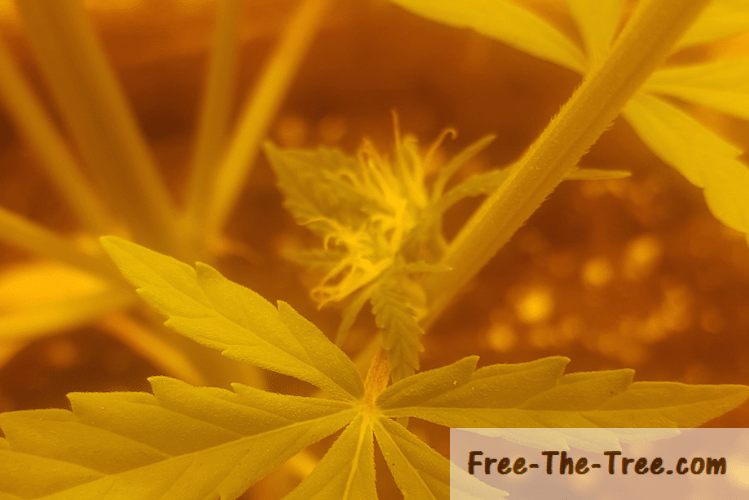
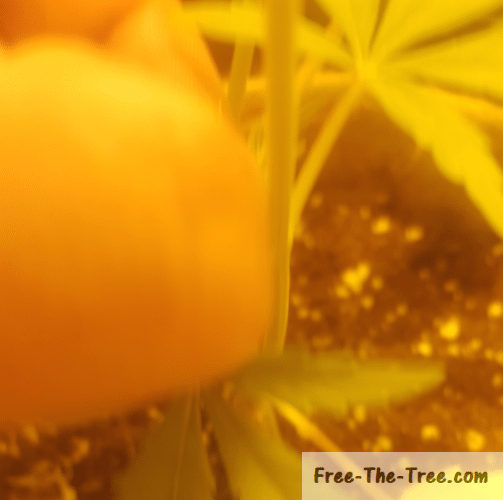

Our trimming session included pop corn buds and a branch of one of our Critical branches.
Why would we cut off a full branch? It was being covered by a large leaf over head so it was either that leaf of the branch, normally it’s pretty straight forward, the leaf has got to go, but in this case we already had pruned too many top leaves so we decided to cut the branch itself.
Here’s some pictures of a plant right before and after a pruning session
Before Pruning Marijuana
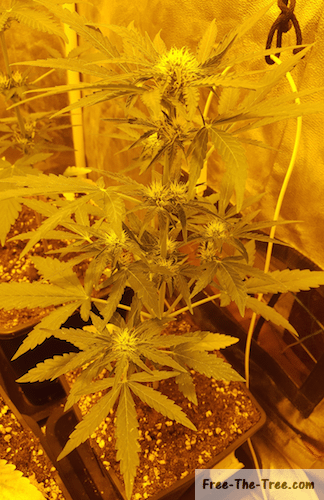
After Pruning Marijuana
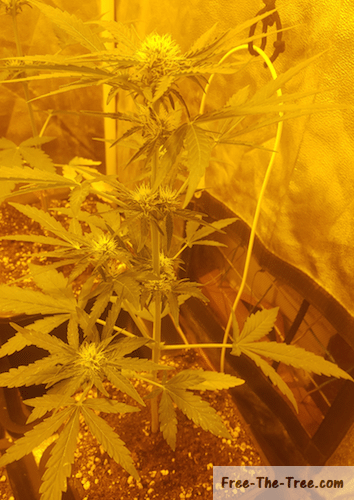
As you can see a large amount of buds are gone and this is good! Instead of having a bunch of small buds the plant will be able to focus on the remaining flowers to make them big and beautiful.
Our pruning was pretty late, as you can see in the images of what we’ve removed the plants had already started producing trichomes, so we lost a good amount of energy.. although in this case I think it’s better late than never
Here’s some of what removed and a focus on what a early marijuana flower looks like. As always click on the image to view it fully
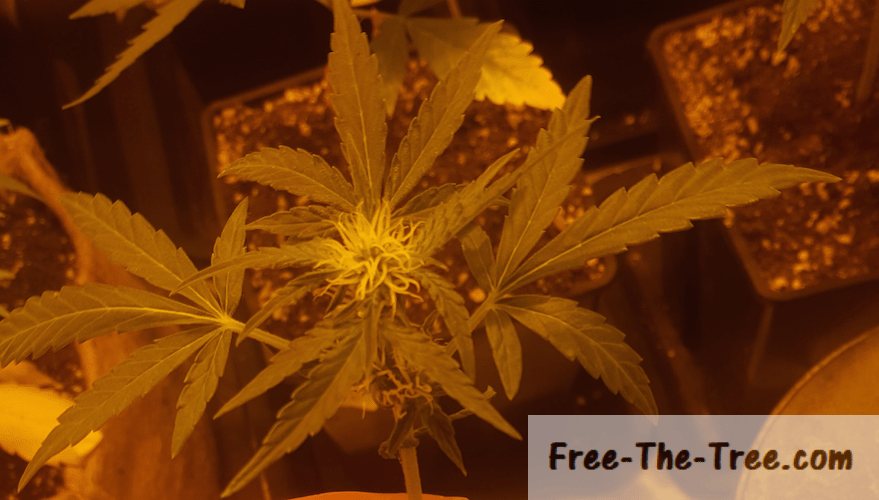
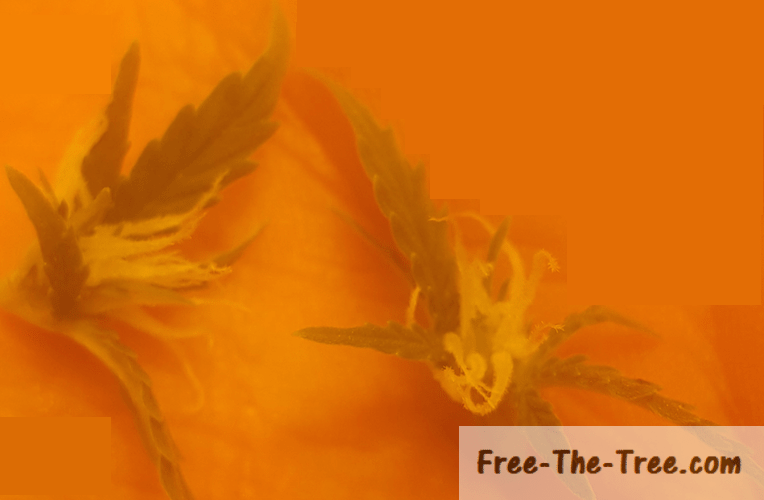
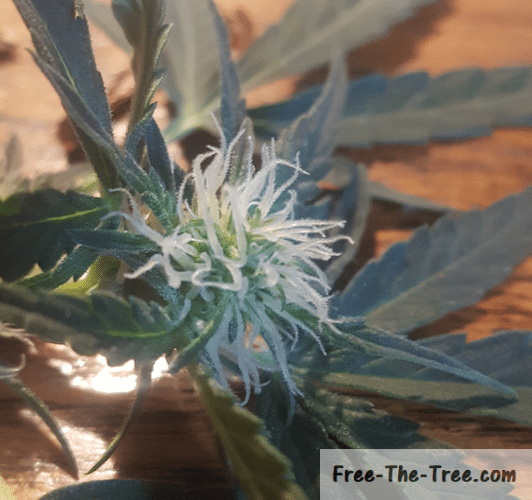
Day 38 and 39 – Calm before the storm
After those 2 pretty active days, day 38 and 39 was pretty calm. We watered out plants with some more nutrients in order to see if the white marks was some type of deficiency (so wrong) and let the plants recover from the recent pruning.
Little did we know that while we though our plants were recovering from an attack they were also being infested by some nasty bugs… But that’s for the next post of our indoor grow journal.
Until then, be safe and grow easy!
Want to share your indoor grow reports?
Send us your email and we’ll get back to you. After that you can start sharing your own experience and help others!
Hey there and welcome (back)!
This week was pretty chill, out little laughing buddha is coming along nicely, the Blue Thai is almost ready to get some cuttings done and we make a niiiiice space cake 🙂
Apart from these d**n fungus gnats, really can’t complain! Let’s get into is
Grow report 3 – Table of content
- Laughing Buddha – Growth and Transplantation
- The fight against fungus gnats
- Transferring to the big tent
- Space Cake
Laughing Buddha – Vegetative growth & Transplantation
Vegetative growth
This week our little sprout spread her leaves fully! Our fear of her getting top-heavy didn’t come true, we even set the fan pointing at her for awhile to test her and she stood strong 🙂
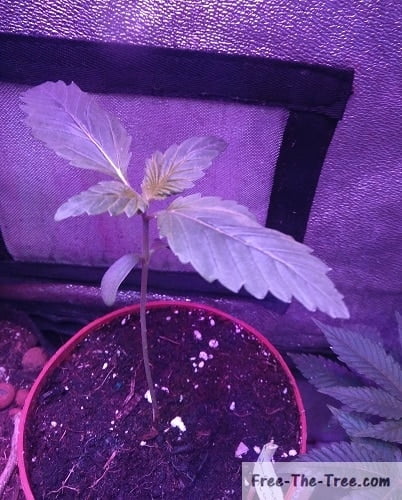
Little one at the beginning of the week
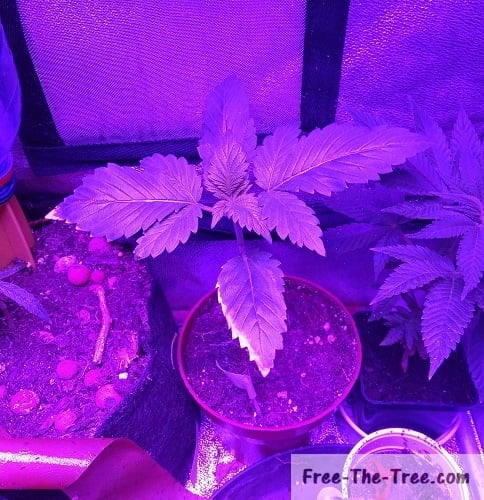
Couple days later, fans leaves well developed
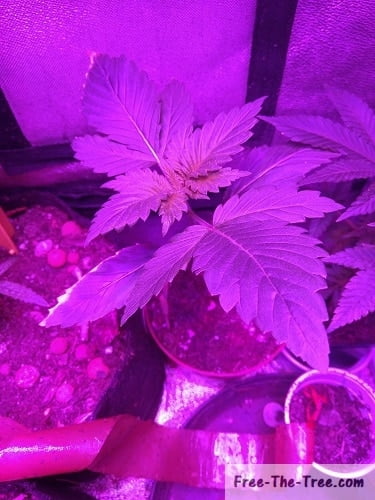
3rd stage growing well – plant starting to lean
First deficiency signs
As you may have noticed in the previous pictures, during the week the little laughing Buddha started showing signs of a deficiency on her first fan leaves.
Pretty sure this is due to the fact that she needs to be transplanted more than a actual nutrient deficiency, sooo let the transplant begin! 🙂
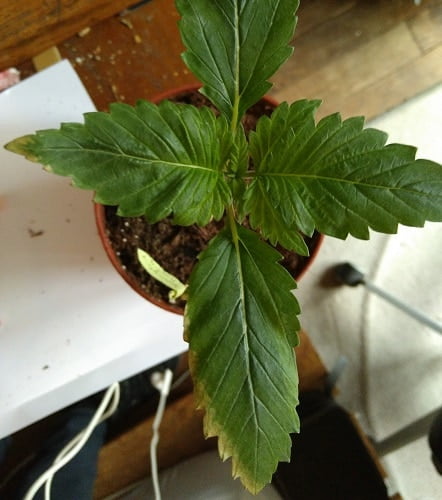
First fan leaves showing deficiency
Transplanting to a 2L fabric pot
As you may be aware, the root mass of a plant is general twice as big as it’s visible foliage.
With that in mind, the pot she’s in is now too small and since it’s made of plastic the roots are most likely spiraling around.
As we started saying above, her first deficiencies are most likely related to this more than any nutrient needing to be added into the soil, although we will start adding some nutrients soon.

Laughing buddha ready to be transplanted
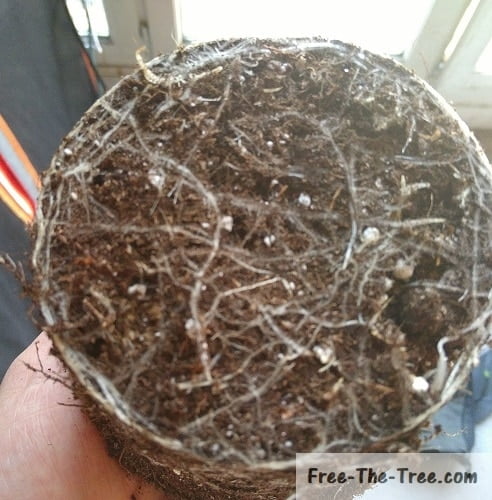
Roots circling in the soil (not good)
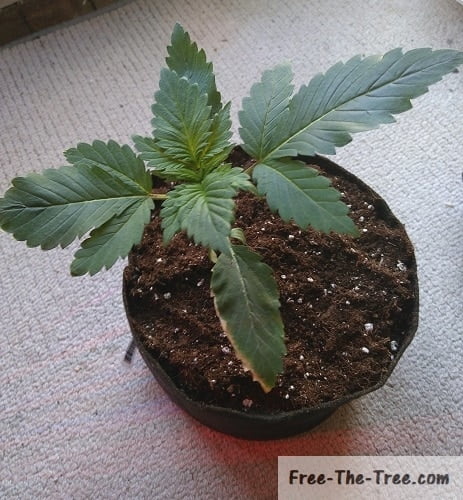
Roots circling in the soil (not good)
We decided to place her into a 2L fabric pot, which will allow the roots to prune themselves, and set her into our main tent, will a 400W LED light system.
The idea is to have her grow quickly, make a couple cuttings and then get her to flower. One of those will be used as a mother, the others will join their clone in the flowering tent 🙂
Fighting off Fungus Gnats
As we pointed out in last weeks grow report we had treated the soil of each pot with a hydrogen peroxyde mix in order to kill all the larvae, the mix being ineffective against the eggs..
Apparently, there were a lot eggs.. as you can see on the image on the right hand side (click to enhance) within a couple days the sticky traps were filled with young fungus gnats.
We’re waiting for a package with some nematodes, gnats natural predators, in order to get fully ride of these sucker..
Hundreds of young gnats on sticky trap
Transferring plants to the big tent
Once we transplanted the laughing Buddha we decided to get the 3 main plants into our bigger room, where the light is much stronger.
Our plan is to get them growing, make couple cuttings, then get to flowering.
With the cuttings we’ll keep one of each to make a mother and the other will meet their sibling in the flowering tents as soon as they’re ready 🙂
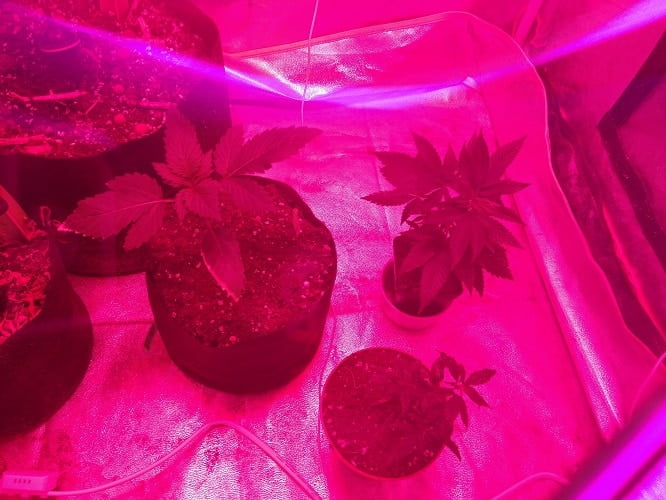
3 plants installed in main grow tent
Space Cookies
If you were with us last week, you’ve followed that we had made some cannabutter; now it’s time to take off.
We used Flo’s famous chocolate cake recipe (;p). Butter wise, to be fully honest, we have noooooo idea of how potent it is, so we’ll find out.
Here’s the ingredients and so pictures to end this post in a tasty manner
Space cookie ingredients (2 cakes made)
- 480g of cannabutter
- 400 of dark chocolate (the cooking kind!)
- 8 eggs
- Sugar
And that looks liiiiike :

480g Cannabutter

Chocolate and Cannabutter heating up
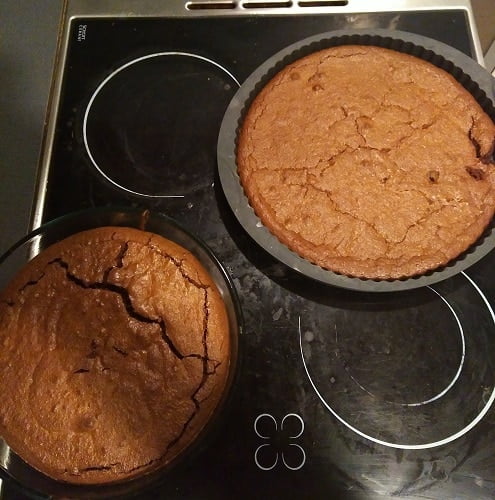
Space Cake out of the oven (wish you could smell em)
Alright got some cake to go eat hehehe
Until next week,
be safe and grow easy 😉
EDIT: that butter was pretty potent, got way too high
Hey there and welcome (back) ! 🙂
This past week was a pretty eventful one, these little ones needed a good amount of attention, which we were happy to provide hehe
As always, before we get into it, here’s a little overview of what we’re going to cover
Grow Report 2 – Table of content
- Laughing Buddha – Early stretch & first leaves
- Critical+ Cuttings – Transplanting and fungus gnats…
- Makin some cannabutteeeer 🙂
- Blue Thai Mother – First cutting
Don’t hesitate to skip ahead if you want, for the others let’s get into the Laughing Buddha, she’s scaring us a baby bit
Laughing Buddha – Early stretch & First leaves
Growth of the first leaves
If you’ve checked out last weeks grow report you’re aware that this little one had just broken ground and spread her cotyledons by the end of last week.
Within 2 days she started growing her first leaves which is pretty awesome 🙂 really want her to get growing quickly so we can make some cuttings and flower them asaaaap

Growth of first leaves
Seedling stem stretching too much
As you can see in the image on the right the stem of this little one is pretty long, showing that she’s not receiving enough light, thus reaching for it.
This is really no optimal, appart from the fact that she’s focusing on vertical growth and not developing foliage (leaves) she will most likely be top heavy once those leaves do start to grow..
This is something we’ve experienced a couple grows ago, and covered a previous grow report.
It’s not the end of the world if she does get top heavy, we’ll give her a crouch until the stem gets strong enough to for her to stand.
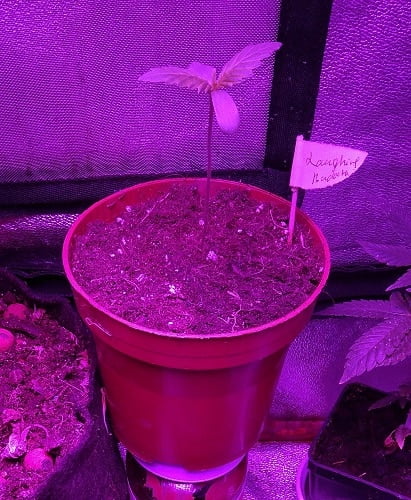
Plant place closer to the light source to avoid any more stretching
Growth of the second stage of leaves
This little one is a fast grower, the first stage of leaves had hardly grown that she was already sprouting the second one.
She’s really looking good, still a bit worries about her balance, when we watered her she wasn’t holding up all that good.
We’ve also added [a much needed] fan in there to get some wind blowing, which will make her develop the stem much more, as well as help dry up the soil after watering, avoiding these damn fungus gnats (getting to that next)
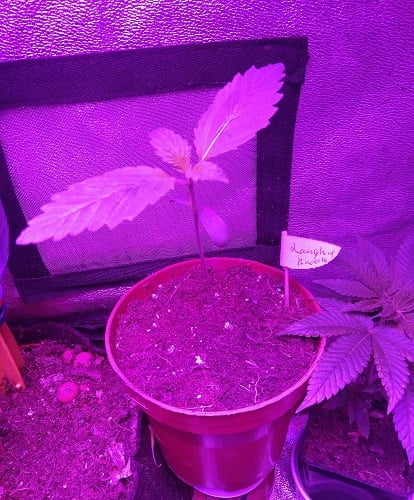
Second stage of leaves growing
Critical+ Cuttings – Transplanting and Fungus gnats
Transplanting the Critical+ plants
Although it was a bit early to do so, we decided to go ahead and transplant the plant that’s going to stay in the vegetation tent as a mother.
For the the 3 other ones we’re going to wait until they grow a bit more than transplant & flower them right away, can’t waiiiiiiiiiit 🙂
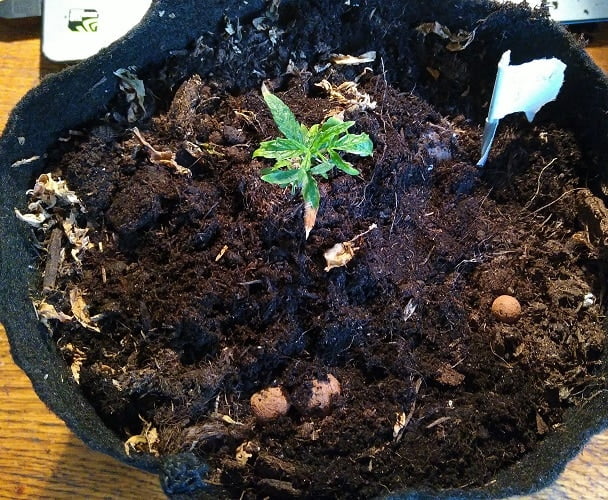
Critical+ transplanted to a 2L fabric pot
Dealing with fungus gnats
After thrips and spidermites here we are dealing with fungus gnats… haven’t signed up for pests control school, but we’re getting close to being experts here -_-“
We had been wondering why our little cuttings were growing so slowly and with unhealthy looking foliage; turns out, it’s linked to the fungus gnat larvae feeding on our babies roots..
We’ll do a full “how to” deal with fungus gnats soon, but basically here’s how we’re dealing with them :
- Sprayed the soil with a mix of Hydrogen peroxyde (1/4) and water (3/4).
This kills the larvae, but doesn’t deal with the eggs or adults - Manually hunted the visible adults
- Set a fan out in order to dry the top soil (fungus gnats need humid soil)
- Put down sticky traps for the adults. This doesn’t seem super effective atm, we’re going to lay out a glass with a little beer for them to drown in (follow a tip through instagram)
Next we’re going to remove the top 3/4cm of soil in order to get any and all eggs out of there, and possibly buy some nematodes to get this soil living with healthy organisms.
Hopefully this is going to be the end of that..

Fungus gnat damage visible on the foliage
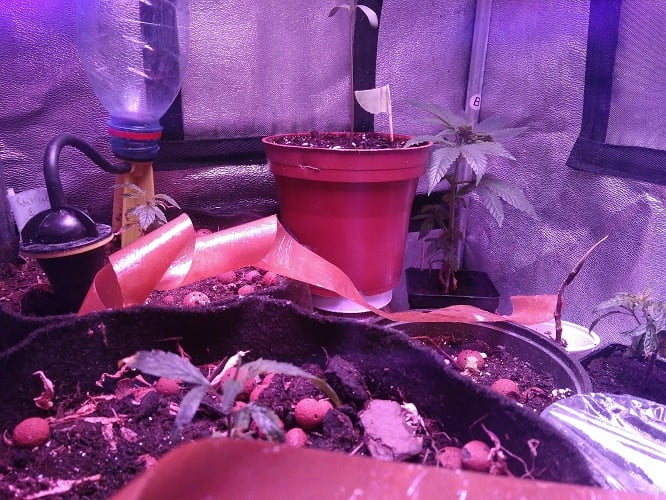
Fungus gnat damage visible on the foliage
Makin’ some cannabutteeer
We had been putting it off for awhile but finally got around to making some cannabutteeeer!
Been saving up the trims of the past 5 grows so really exited to see what it’s going to turn our to be hehehe.
We’re not going to detail all the steps here, if you’re trying to make some check out our recipe over here, that said here’s a couple pics just cause 😉
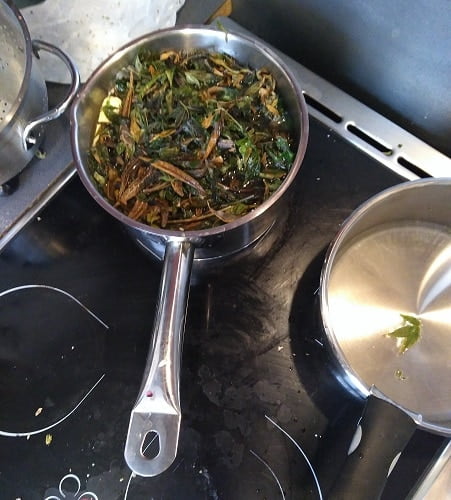
Leaves&Butter chillin in water
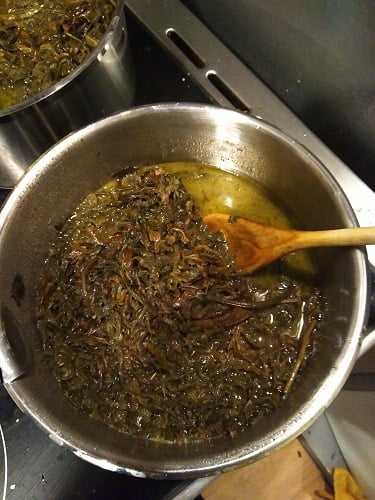
Leaves&Butter chillin in water
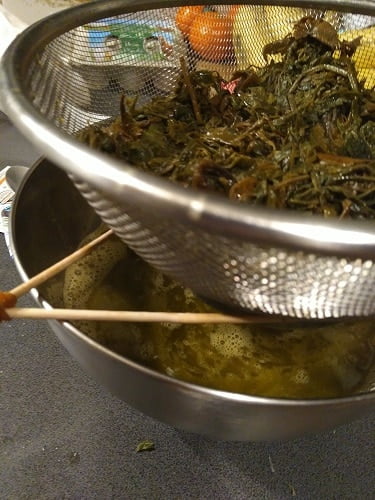
Straining the water&cannabutter mix from the leaves
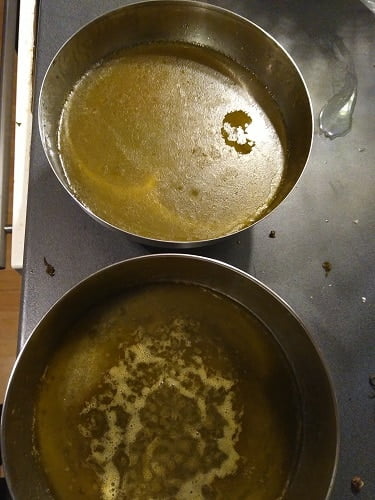
Cannabutter&Water
ready to cool down
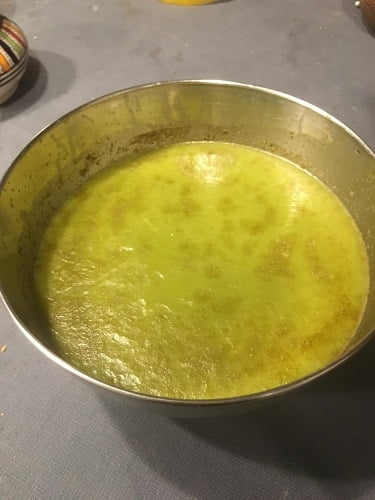
After 24 hours in the fridge,
cannabutter is solid.

Water poured out leaving the cannabutter ready for cooking! 🙂
Blue Thai’s first cutting
Since we don’t want to flower our last blue thaï plant, we’ve decided to keep this one as a mother and flower some cuttings. Thing is… i’m not super super patient (workin on it ^^), and want to get her into the flowering tent asaaaaap.
In that spirit, I looked for a nice little side branch big enough to make a cutting out of.
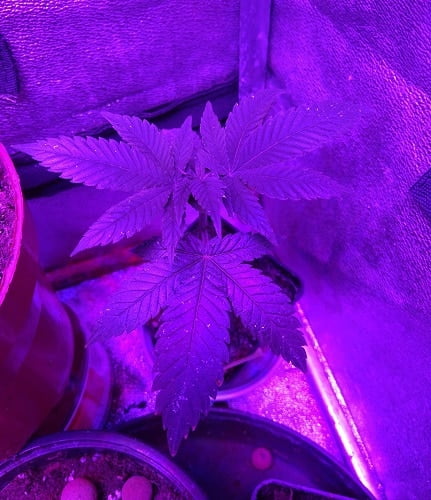
Blue Thai mother plant
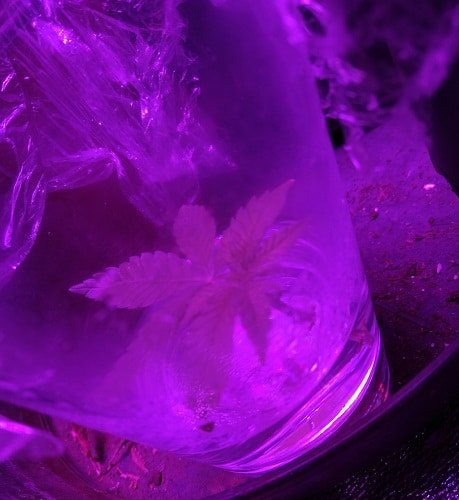
Blue Thai mother plant
As you can see, we spotted one that was small, but not too small, and went for it. Hopefully, since it’s such a young sprout, it’ll still have a bunch of rooting hormones and will take quickly.
In order to keep it in a nice, humid, environment we placed it in a glass of water and placed cellophane over it, with a couple whole.
Water droplets quickly formed on the sides of the glass, showing that humidity levels are high. Hopefully she’s going to take!
Alright folks that’s all for this week,
Until next time, be safe and grow easy!
P.S: if you want to keep in touch, come say hi on our insta 😉
Hi There and welcome (back) to Free the Tree!
This past week we’ve seen some nice bud growth all around, although the BBC is still showing signs of Phosphorus deficiency… Hopefully we’ve added enough PK for them to be happy, and not too much for the others..
You can also see that Cheese plant was really getting too tall and close to the light source, which we can’t really raise much more than it is or else the Big Buddha Cheese and Blue Kush won’t have enough light.. So we decided to fold her Apex.
This is the first time we’ve done so many different strains at once and I think we went a little too far by having 5 different ones in there;
Furthermore, the BBC’s are mainly in re-used soil, maybe even dating back 4 grows, I think it may be totally out of nutrients and needs some time to recover..
Let’s get into it!
Phosphorus deficiency
If you read last weeks post you’ve seen that we’ve been dealing with phosphorus deficiency issue showing up so at your last watering we pumped up the amount of PK in the solution.
Since then we haven’t seen new leaves being affected by this deficiency which is a good sign, hopefully it’s the last one of this grow..
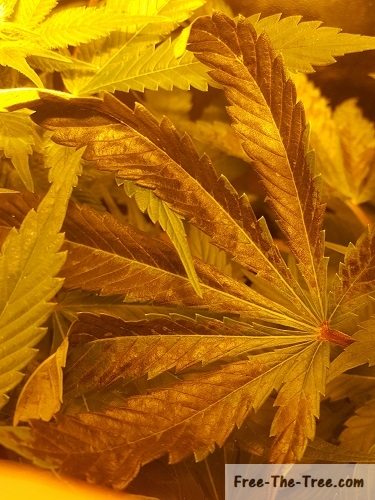
Leaves turned purple/black
Nice Bud growth
Although we’ve been seeing these deficiencies, over the past weeks the buds have been nicely developing, especially on the Big Buddha Cheese.
Her flowering cycle seems to be shorter than the 3 other plants, we might finish by harvesting her a couple weeks earlier 🙂
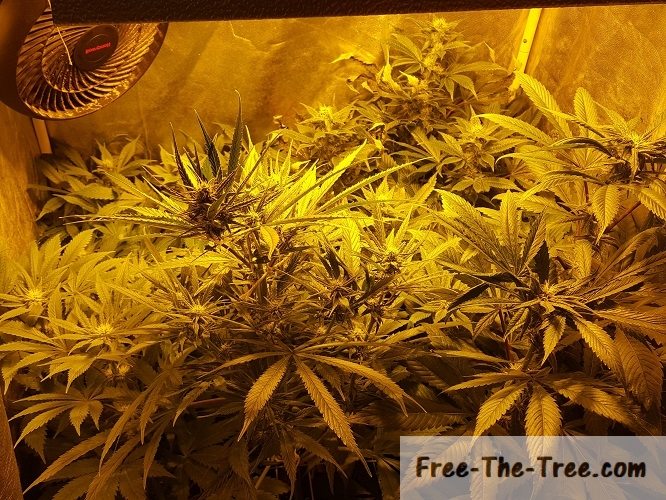
Buddlets developing into nice buds
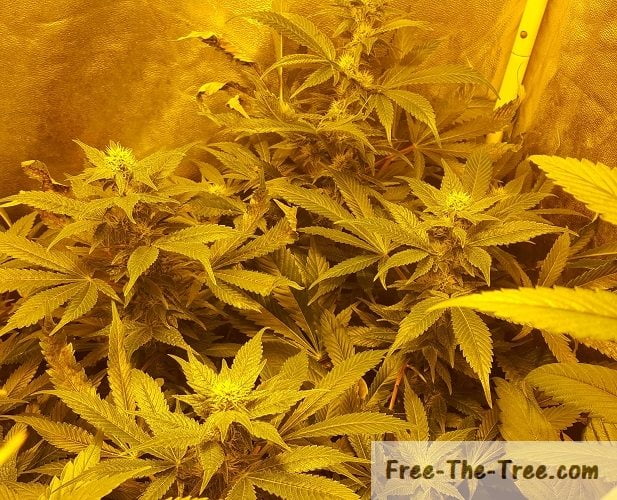
Big Buddha Cheese further along than the others
You can clearly see that the BBC is further along the road than her cousins in the room, her buds are looking sooo nice and their full of trichomes, really can’t wait to smoke up.
The smell has also been getting pretty intense, the whole room smells strongly, and when I open the grow room an even stronger odor is released, smelling beautifully sweat. It’s a real pleasure to see these little ones grow!
Apex Too close to the Light
Our cheese plant is the only one we didn’t weave on the screen since it was so small, at first. Now she’s way too tall messing up our whole canopy, make the Blue Kush stretch and is covering up the light of the blue Thai.
On top of all that she’s now way too close to the cooling hood and the Apex is starting to cook, really not an idea situation
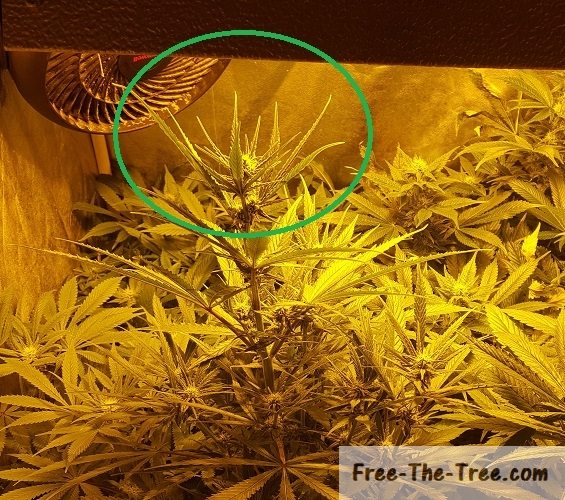
Leaves going vertical
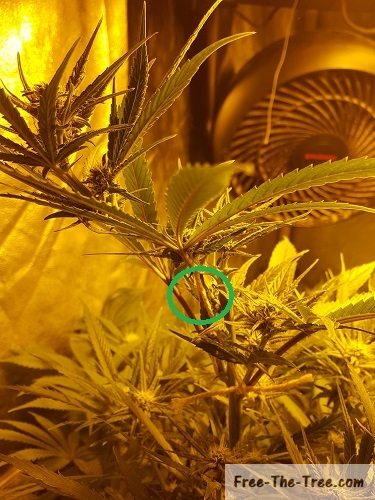
Super Cropped Apex during the flowering stage
Since we didn’t want to up the hood even more, making it too far for all the other lights, we decided to super crop the apex. Don’t really know what it’s going to give out, we’ve read left and right and there really all opinions about supercropping during the flowering stage.
Since it was divided we decided to go ahead and try it out. This little one will have been super cropped twice during this grow
I think that this will make her produce fatter buds lower within the stem and the top bud might be a little smaller and with less THC density, but… at least it won’t be all burnt up.
Alright folks that’s all for this one!
Until next time, be safe and grow easy 😉
Don’t want to go yet? Check out our other Grow Reports
Check out all our Indoor Growing Tips
Hey there and welcome (back) to Free The Tree!
We’ve now arrived at the final post of this grow, it was short but intense! But don’t worry we’ve already got 5 seeds that have germinated and 4 Big Buddha Cheese clones going, next series is going to be even better 🙂
But we’re getting ahead of ourselves, today we’re going to cover the harvest and curing of our 2 Fruit Auto flowering Marijuana plants, the 2 others aren’t ready yet.
As you will see, the 2 we’re about to cut are are super small, but the 2 one buds are looking ok considering, especially one of them. Regardless, as soon as those autoflowering plants started flowering on their own we knew that this would be a small one;
Let’s get into it!
Day 59 – Holding back on harvesting
By now we had been observing the trichomes every day or two for the past 7 days or so, the two plants on the left were entering their 3rd and last cycle of browning pistils and most of the trichomes were milky. Furthermore they had been in a Nitrogen deficiency state for awhile now, so we new those buds were going to be super light, but suuuper tasty.
So really at this point they were ready to be harvested, but so small that we wanted to give them as many more days as possible to fatten..
The two one bud plants (on the right) were no where near ready, many trichomes were still clear, they had little or no signs of Nitrogen deficiency and they hadn’t even entered the 2nd round of browning pistils. We figured we had at least a week left on those two.
Here’s a couple of pics of these babies at this stage, as always you can click on them to see the full screen version.
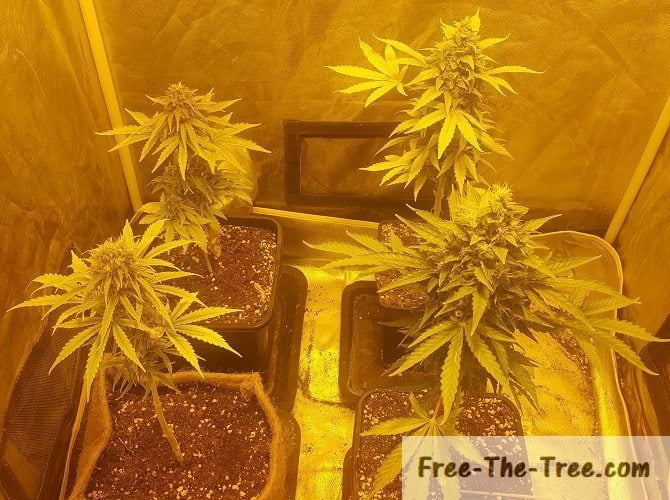
4 Fruit Strain plants at the end of the flowering stage

One of the 2 One Buds
Now to show you with more detail what we meant when we said that the one buds still had white pistils and the other 2 plants were entering the 3rd phase of browning pistils here’s 2 close-ups on one of each
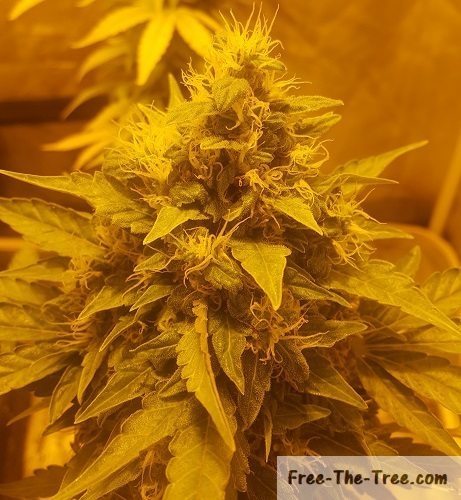
Mostly white pistils on the buds

Marijuana Pistils have started to become brown
Day 61 – Harvesting and curing the 2 first plants
By this time we started seeing some trichomes starting to turn and golden/brownish color, which is a sign that the THC levels are reducing and the CBD is rising. Depending on the type of plant and what you want as a high you might want to wait more, but since this is a Hybrid we don’t want her indica side to come out too much, it’s chop chop time.
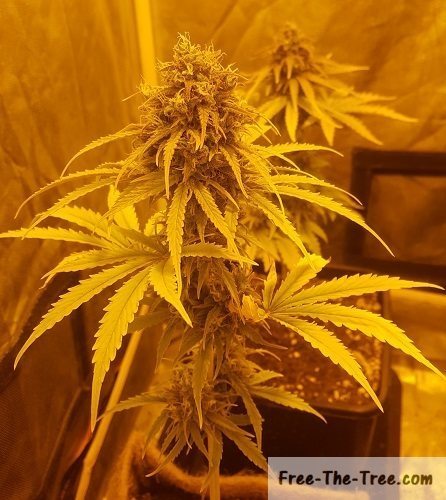
Fruit ready to be harvested
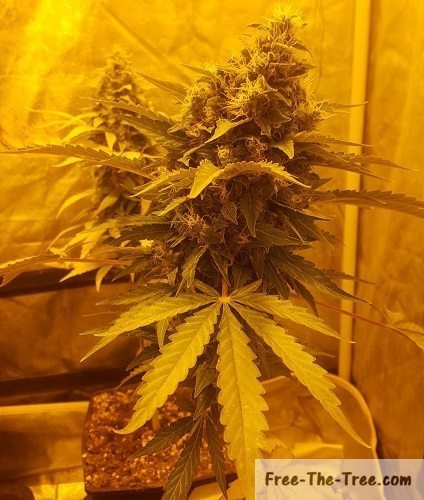
One Bud leaning under bud weight
As you can see once out of the grow room her colors finally show on camera 🙂 Her strong nitrogen deficiency is a sign that her taste should be great, and those purple hints on the top of the buds just make her sexy haha.
We also placed a little picture of our one bud in the middle. As you can see her root system and stem aren’t strong enough to hold the weight of the bud. We had to strap her up a little in order to help her stand up straight.
Getting back to the harvest, now that the plants are cut we need to get to curing them, we covered that with more detail in our previous article so we won’t go in detail on how to do so, but here are some picture (don’t expect the fattest buds..)
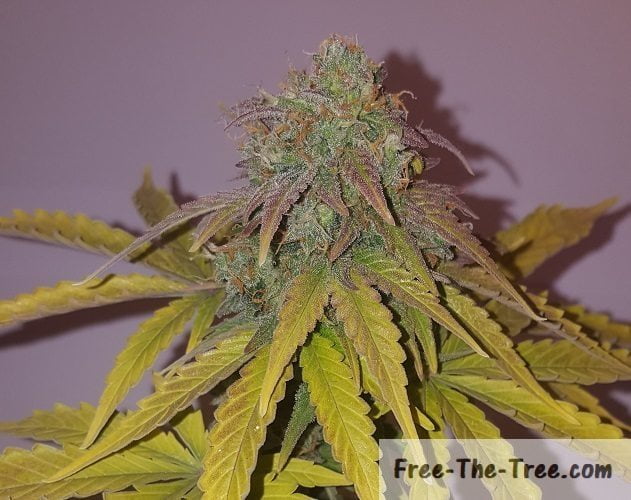
Purple bud
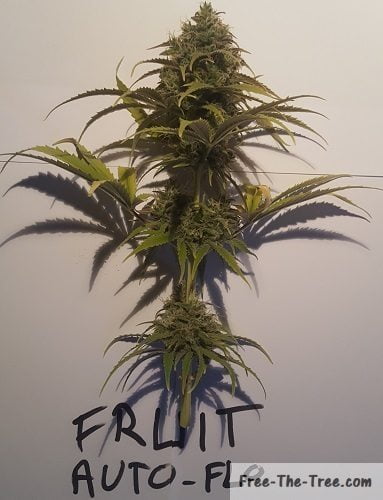
Fruit plant before curing
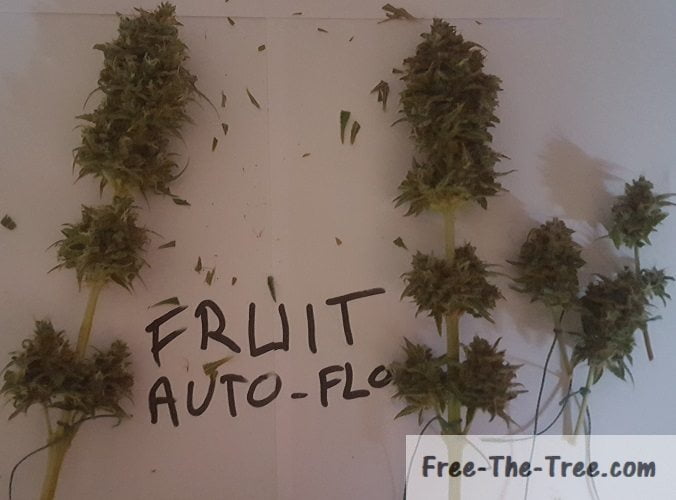
2 Fruit plants after curing
Crazy how much size they lose before and after curing them no?! Now it’s time to get them to dry for about 10 days.
[su_quote]Reminder: As we said in our previous article, don’t throw out your stems and leaves, you can reuse them for many things, from Hash with the leaves to Tea with the branches; (how to make hash over here) [/su_quote]
Day 63 – Nitrogen Deficiency kicking in
In just 2 days the Nitrogen deficiency had started to advance, the bottom leaves started drying and were almost ready to fall off and the symptoms started spreading further up the plant.
Here’s a couple pictures of the 2 last plants of this cycle
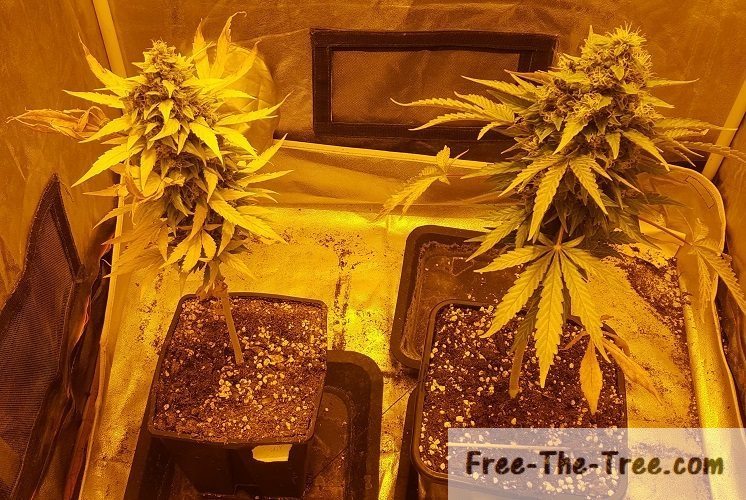
Nitrogen deficiency spreading upward
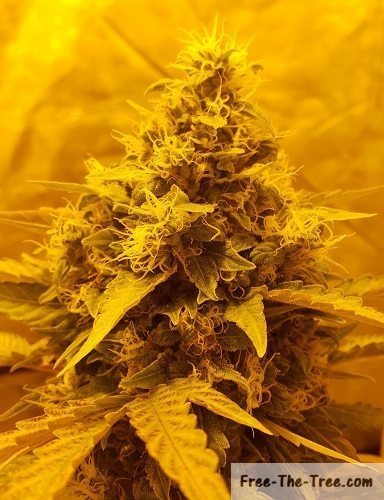
Close up on bud on the right
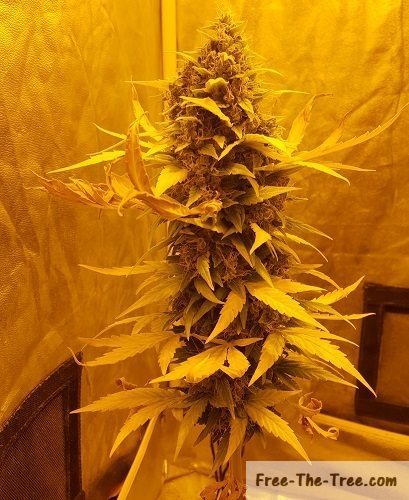
2nd plant about a week short of harvest
Day 68 – Harvest and Curing the last plants
By now the nitrogen deficiency had advanced well, the pistils had started to brown for their 3rd time and the trichomes were all nice and milky, time harvest these last babies! Here’s what they looked like
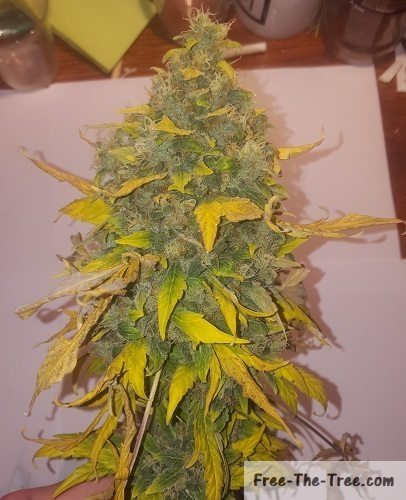
Plant 1

Plant 2
As always, after this we got to get curing, here’s a couple more picture
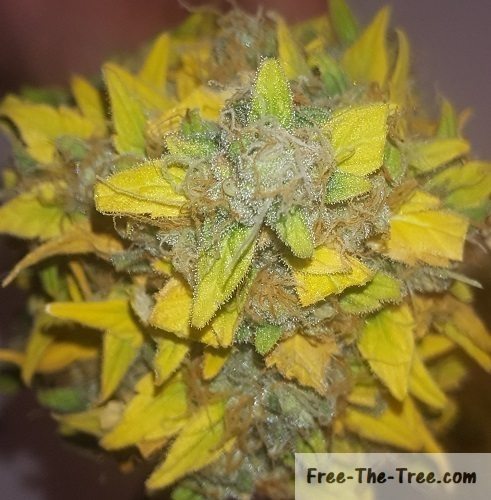
2nd plant about a week short of harvest

Close up on bud on the right

Plant 1 and 2 after curing
Now that we’ve cured them we got to get them drying. As we’ve said in the previous post, we just tie them upside down either in the grow room or in a cupboard. Since we’ve already started germinating new seeds this time they’re going in the cupboard!
Here’s what the 4 plants look like in there, you’ll be able to see right away the different in size and in color. The color difference is due to the fact that the 2 smaller plants are now in their 8th day of drying. Actually a little of the size difference is also linked to this, since while drying they loose in mass.
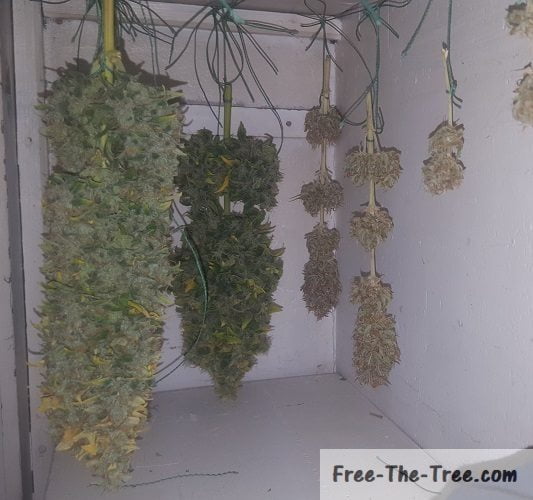
Fruit Plants drying in cupboard

Scissor full of resin and pistils
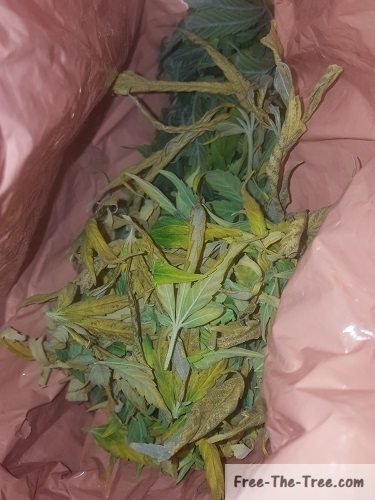
Leaves ready to go into the freezer for later use (home made hash soon!)
Well that’s it for this one guys, next time we’ll cover the germination of the Blue Thai, Blue Kush and the Cheese seeds, can’t wait 🙂
Until then, be safe and grow easy!
Don’t want to leave just yet? Check out our other grow reports and indoor growing tips!
Grow Reports
Indoor Growing Tips

